RESOURCES - PUBLICATIONS
Using Backpack Mist Blowers to Control Adult Mosquitoes -Creating Barriers for Homeowners’ Green Space

Fred Whitford, Director, Purdue Pesticide Programs
Lee Green, Senior Medical Entomologist, Indiana Department of Health
John Obermeyer, Integrated Pest Management Specialist, Purdue University
Joe Becovitz, Pesticide Program Specialist, Office of Indiana State Chemist
George Balis, Regional Manager, Clarke Mosquito Control
Mark Sybouts, Product Development Manager, Advanced Turf Solutions
Bob Andrews, Executive Director, Indiana Professional Lawn and Landscape Association
Kevin Leigh Smith, Continuing Lecturer and Communication Specialist, Purdue Agricultural Sciences Education and Communication
Introduction . . . . . . . . . . . . . . . . . . . . . . . . . . . . . . . . . . . . . . . . . . . . . . . . . . . . . . . . . . . . . . . . . . . . . . . . 4
Mosquito Biology Explains Why We Do
What We Do. . . . . . . . . . . . . . . . . . . . . . . . . . . . . . . . . . . . . . . . . . . . . . . . . . . . . . . . . . . . . . . . . . . . 8
Turning Down Customer Requests for
Mosquito Treatments. . . . . . . . . . . . . . . . . . . . . . . . . . . . . . . . . . . . . . . . . . . . . . . 13
Residential Treatments Aim to Reduce Bites,
Not Prevent Diseases. . . . . . . . . . . . . . . . . . . . . . . . . . . . . . . . . . . . . . . . . . . . . . . . 15
Have a Plan Before Strapping on
Your Backpack Mist Blower. . . . . . . . . . . . . . . . . . . . . . . . . . . . . . . . . . . 16
Water, Water Everywhere. . . . . . . . . . . . . . . . . . . . . . . . . . . . . . . . . . . . . . . . . . . 20
Treatment Methods and Considerations . . . . . . . . . . . . 26
Adult Control Relies on Backpack
Mist Blowers. . . . . . . . . . . . . . . . . . . . . . . . . . . . . . . . . . . . . . . . . . . . . . . . . . . . . . . . . . . . . . . . .31
Think Shade When Applying. . . . . . . . . . . . . . . . . . . . . . . . . . . . . . . . . . . . . 34
The Pesticide Label: A List of Do’s and Don’t’s. . .44
Resistance Management. . . . . . . . . . . . . . . . . . . . . . . . . . . . . . . . . . . . . . . . . . . . 49
Conclusions. . . . . . . . . . . . . . . . . . . . . . . . . . . . . . . . . . . . . . . . . . . . . . . . . . . . . . . . . . . . . . . . . . . . . . . 50
Acknowledgements . . . . . . . . . . . . . . . . . . . . . . . . . . . . . . . . . . . . . . . . . . . . . . . . . . . . . . .51
Disclaimer. . . . . . . . . . . . . . . . . . . . . . . . . . . . . . . . . . . . . . . . . . . . . . . . . . . . . . . . . . . . . . . . . . . . . . . . . . . 51
INTRODUCTION
Although buzzing mosquitoes are annoying, their bites can leave more than itchy welts behind. Mosquitoes also carry the potential to infect humans, pets, horses, and other animals with debilitating and deadly diseases. Biting mosquitoes can adversely affect our ability to enjoy backyard barbecues, concerts in the park, or simply strolls through the neighborhood. If you are near vegetation outside during the mornings or evenings in the warmer months, there is a good chance you will encounter mosquitoes. In many cities and towns, citizens support publicly funded programs that seek to control mosquito populations and limit their public health effects on the community. Often, health officials, biologists, and entomologists intensively manage these communitysupported programs. The managers use the latest technologies and advances in scientific knowledge to guide them.
Depending on staff and funding, communitysupported programs can use products to control larvae in catch basins and other stagnant water sites, use collection traps to monitor for adult numbers, sample viruses in adult mosquitoes, and provide educational materials to encourage the public to help reduce mosquito numbers. Community-supported programs are the most active when it’s possible to transmit mosquito-borne diseases in local populations. However, high populations of nuisance-biting mosquitoes will also trigger most community-supported programs to ramp up, too. That is when we see the trucks driving throughout the community targeting flying adult mosquitoes with aerosolized control materials.


Enjoying the outdoors — whether in the backyard, neighborhood, or community — is important. Mosquitoes can take away that enjoyment by biting and drawing blood.




While community-supported programs reduce both nuisance and disease-carrying mosquitoes, there are plenty of breeding sites on private property that are left untreated. These untreated sites around private property took on new importance after Florida officials detected the mosquito-transmitted Zika virus in 2016. National papers and television news reported that the virus could be passed from the infected mother to harm her unborn child. These alarming headlines brought renewed attention to controlling mosquitoes on private property.
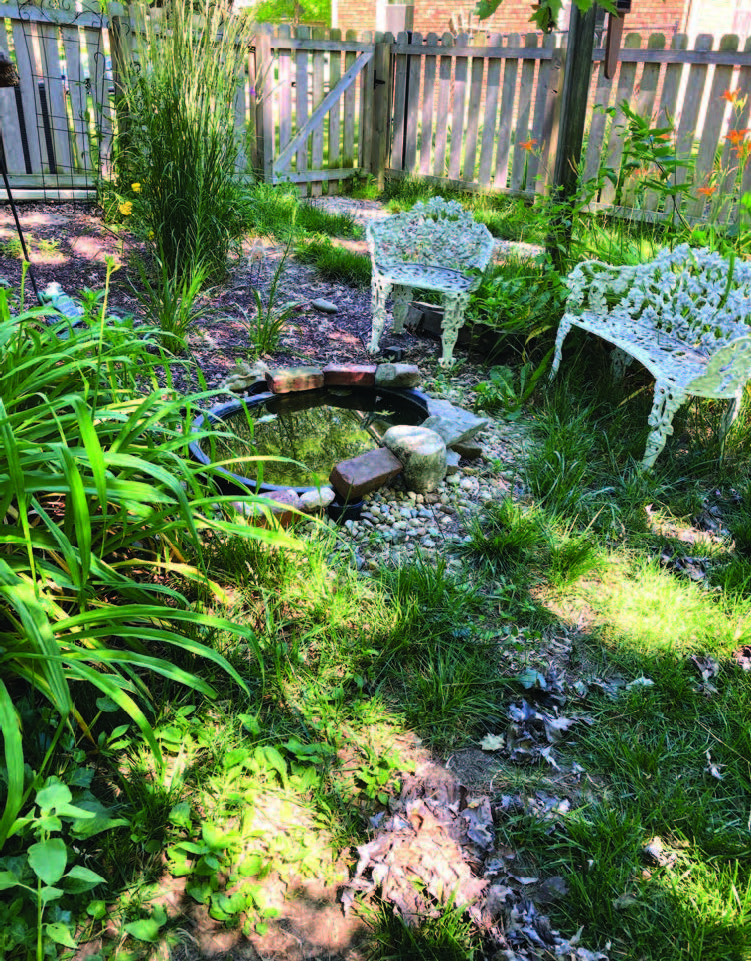 Standing water (such as this fish pond) can become a mosquito breeding place.
Standing water (such as this fish pond) can become a mosquito breeding place. 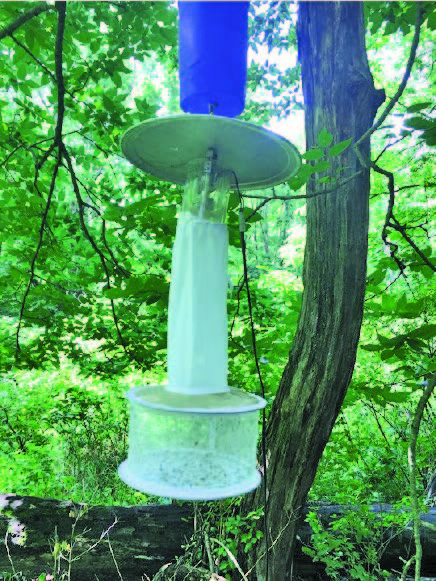 An adult mosquito trap allows individuals to identify different species and their abundance.
An adult mosquito trap allows individuals to identify different species and their abundance. 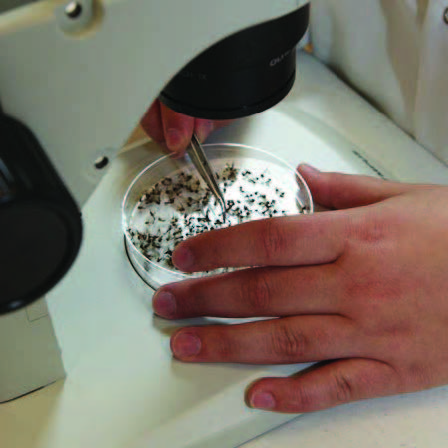 Indiana Department of Health officials will analyze which mosquitoes are being captured in traps and whether they are carrying diseases like West Nile virus.
Indiana Department of Health officials will analyze which mosquitoes are being captured in traps and whether they are carrying diseases like West Nile virus. 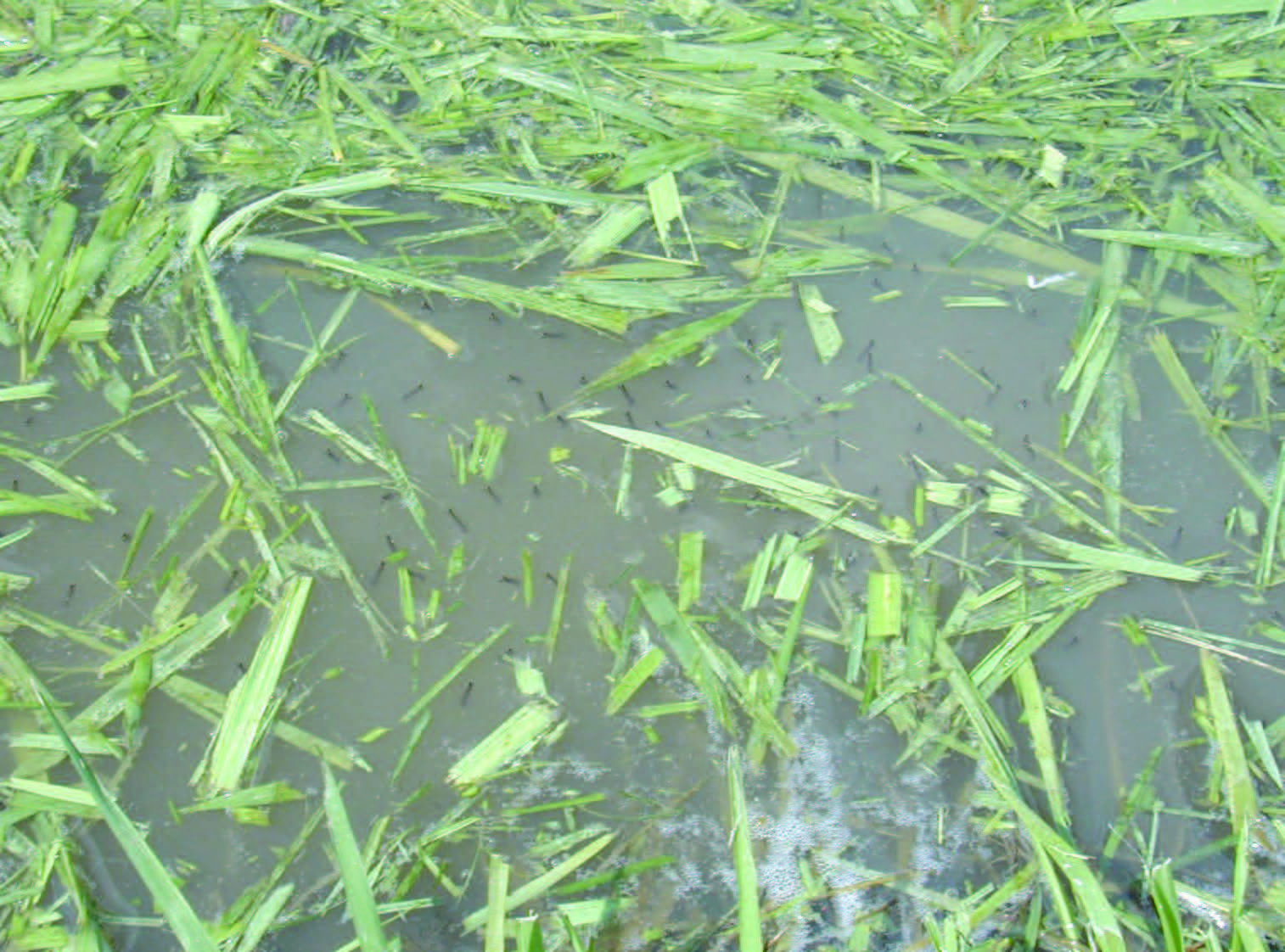 What the public often doesn’t notice is the amount of work that gets invested to control larval and adult mosquitoes on publicly managed lands, abandoned properties, roadside ditches, marshes, and more. Water standing in a ditch can become a breeding site for adult mosquitoes in a short time. Such breeding sites can produce thousands of mosquitoes, which is evident by the larvae clearly seen in this photo.
What the public often doesn’t notice is the amount of work that gets invested to control larval and adult mosquitoes on publicly managed lands, abandoned properties, roadside ditches, marshes, and more. Water standing in a ditch can become a breeding site for adult mosquitoes in a short time. Such breeding sites can produce thousands of mosquitoes, which is evident by the larvae clearly seen in this photo. Residents also began noticing mosquitoes on their properties when the COVID-19 pandemic caused them to spend more time at home. Over time, more people chose to work from home. This meant they were closer to home, spending more time outdoors, watering landscape plants, playing soccer in the backyard, and letting the dog out. Many people were surprised by the number of mosquitoes they encountered, which raised their level of concern.
As a result of this concern, companies emerged to meet the demand from customers who were calling to seek mosquito management on their properties. Some businesses offer only mosquito control services, while other existing lawncare and pest control businesses offer it as an add-on service. One thing is certain, homeowners’ quest to use their outdoor living areas free of biting mosquitoes continues to propel the growth of the residential mosquito control industry.
Comparing Community-Based and Residential Programs
While there are similarities between community-supported mosquito control programs and residential mosquito control, there are significant differences between the two. The primary goal for most community-supported programs is to reduce disease transmission to people; however, some programs also focus on controlling large nuisance mosquito populations that may affect animal health or the economy. In some cases, federal and state programs target mosquitoes that transmit equine encephalitis virus to humans and horses. West Nile virus also is a major target. The decision to treat is often based on a threshold that accounts for the number of mosquitoes present, the species collected, and whether pathogens have been detected within that population of mosquitoes.
| Community-Supported Program | Residential Program |
| Managed by public agency | Managed by commercial business |
| Program paid by public funds | Program paid by property owner |
| Focused on controlling disease | Focused on nuisance biters |
| What is best for the community | What is best for the customer |
| Larval control a priority | Larval control often left to the customer |
| Adult mosquito control | Adult mosquito control |
| Treatments over larger areas | Treatments on single property |
| Control flying mosquitoes | Treat mosquito resting sites |
| Non-residual insecticides control adults and last about a day | Residual insecticides last weeks |
Homeowners concerned about nuisance biters in their backyards have completely different goals and action thresholds than community-supported programs. For some, only a few annoying mosquitoes may pose enough of a threat to a hypersensitive family member to trigger an application. Residential mosquito control companies can tailor adult mosquito programs for their customers’ needs based on the characteristics of their properties. Companies can help customers understand the importance of eliminating breeding sites such abandoned plastic swimming pools, pots, buckets, and sagging gutters. Working together provides seasonlong customer satisfaction.
This publication provides instruction about how to reduce adult mosquito populations on private property using a backpack mist blower. The topics we discuss include:
• How mosquito biology and behavior is relevant to the application
• What it means to conduct a site assessment
• The desired characteristics of barrier insecticides
• Why insecticide labels are so important
• On-site recommendations to consider when making an application
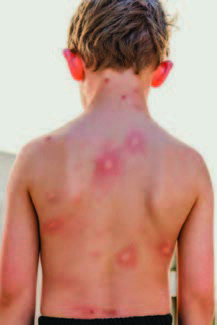 Some people have allergic reactions to mosquito bites.
Some people have allergic reactions to mosquito bites. 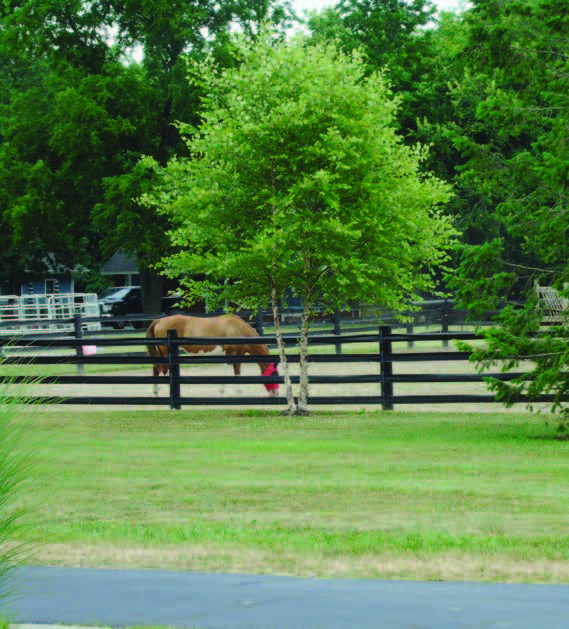 Mosquitoes can also
harm horses, dogs, and other pets.
Mosquitoes can also
harm horses, dogs, and other pets. 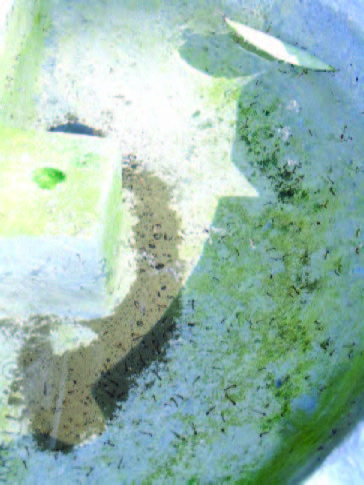 Water that remains in a water fountain can attract female mosquitoes for laying eggs. Note the larvae in the water.
Water that remains in a water fountain can attract female mosquitoes for laying eggs. Note the larvae in the water. 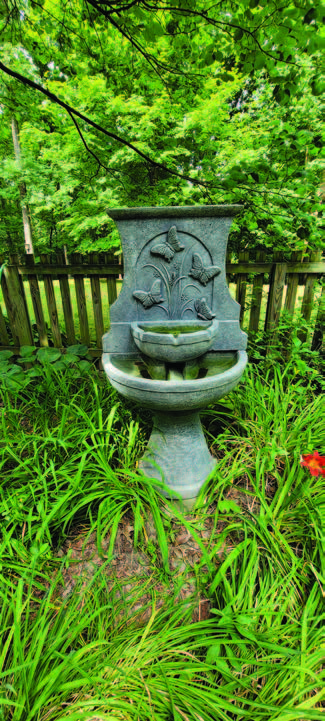 water fountain
water fountain MOSQUITO BIOLOGY EXPLAINS WHY WE DO WHAT WE DO
Mosquitoes are one of the most medically important insect groups in the world. Of the 55 commonly captured species collected by the Indiana Department of Health, only about a dozen species of mosquitoes can transmit diseases.
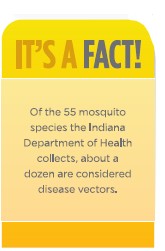
Applicators must understand the biology and behavior of mosquitoes if they expect to help customers and make a living in this field. Knowing both the biology and behavior of mosquitoes in your area creates the foundation that explains why we do what we do. While you don’t need to know the depth of detail that department of health professionals or entomologists do, you should know how a mosquito develops and seeks a blood meal. That knowledge is pivotal to the success or failure of residential mosquito programs. It tells you exactly where to target your program.
Female adult mosquitoes lay eggs on or near stagnant water. Except for the adult stage, all other mosquito development stages (egg, larvae, and pupae) occur in water. The water source can be naturally occurring or human-made. Some human-made examples include clogged gutters, pots and buckets, tires, bird baths, and fire pits. This often means that the number of mosquitoes in a neighborhood might be low, but individual residences might have intolerable populations because of standing water on the property.
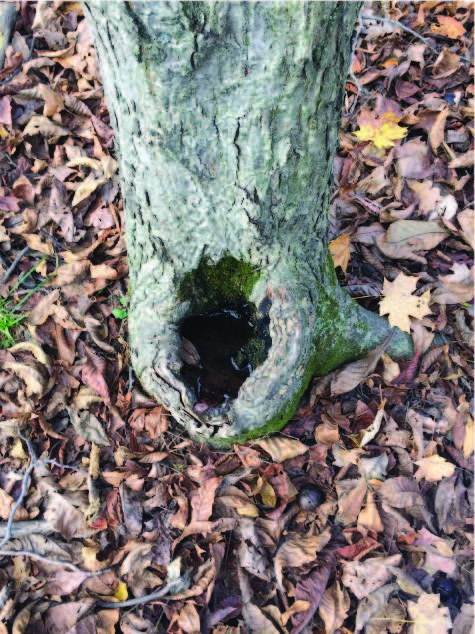
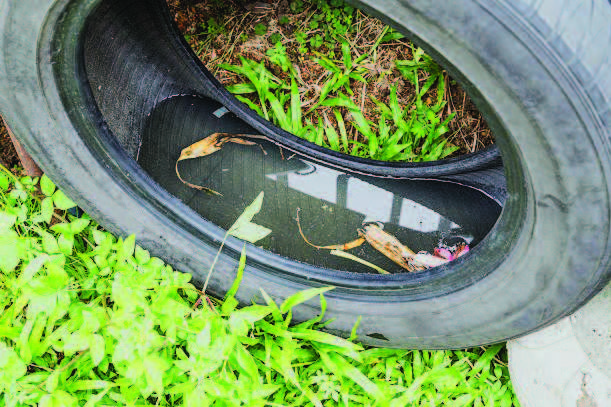 Just about any source of water can breed mosquitoes.
Just about any source of water can breed mosquitoes. 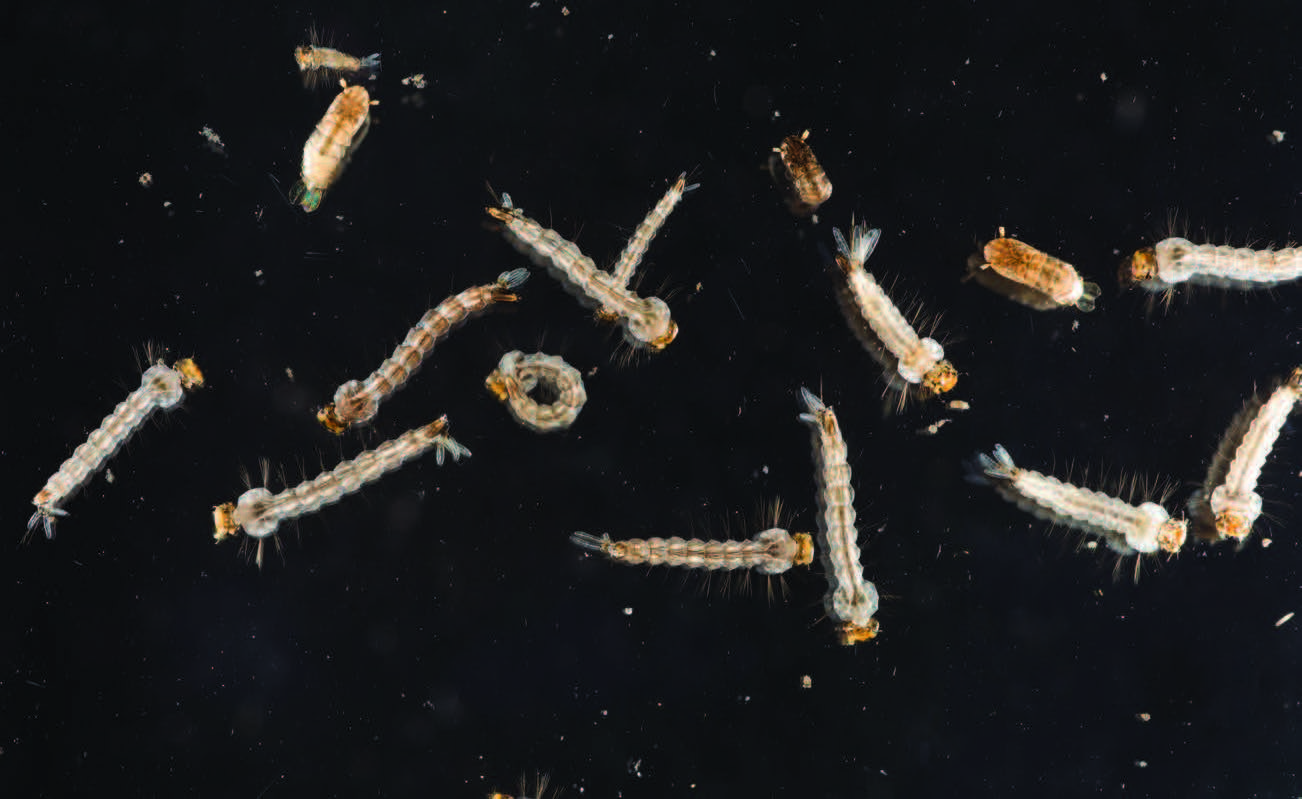 Mosquito larvae, known as “wrigglers,” feed on microorganisms in water and obtain oxygen from the atmosphere.
Mosquito larvae, known as “wrigglers,” feed on microorganisms in water and obtain oxygen from the atmosphere. The eggs hatch into larvae, which are called “wrigglers” because of the way they move in water. Depending on water temperature and species, wrigglers can fully grow in as little as five days. Newly hatched larvae are very small and hard to see, but people can easily detect full-grown wrigglers by their erratic movements. Wrigglers move about to feed on microorganisms that develop from the decaying organic leaf litter, solids, and nutrients in the water. Larvae must make frequent trips to the water surface to breathe, so their modified “tails” can take in air above the water. In natural environments, larvae live around the banks of ditches, ponds, wetlands, and marshes only where the shallow water and dense vegetation protect them from predators like fish and rippling water that could drown them as they breathe.
These shallow areas also provide wrigglers with their preferred food source, which is suspended organic s lids and nutrients. Mosquito larvae thrive in human-made containers of stagnant water because there are no predators. At the end of the larval stage, mosquitoes transform into pupae. The pupa, also known as a “tumbler,” tumbles about, not for feeding, but to get air at the water’s surface and to avoid predators. Adult mosquitoes, both males and females, emerge from the pupae. Mosquitoes complete their lifecycle from egg to adult in as little as a few days depending on water temperature and species.
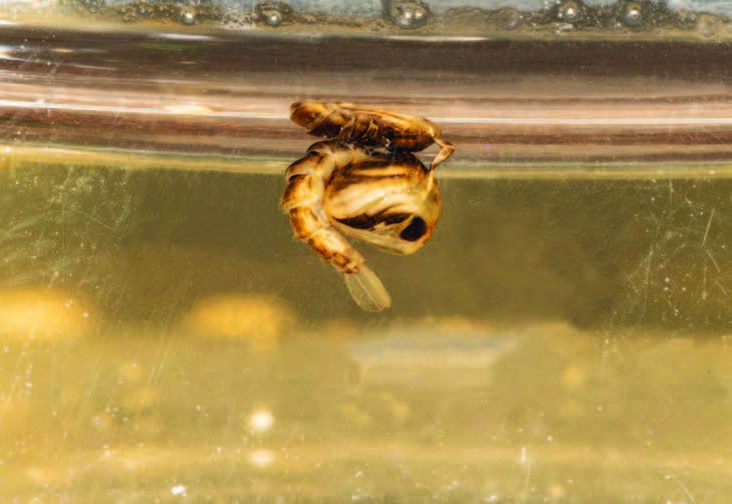 Larvae (wrigglers) turn into pupae (tumblers) and soon emerge as adult mosquitoes.
Larvae (wrigglers) turn into pupae (tumblers) and soon emerge as adult mosquitoes. 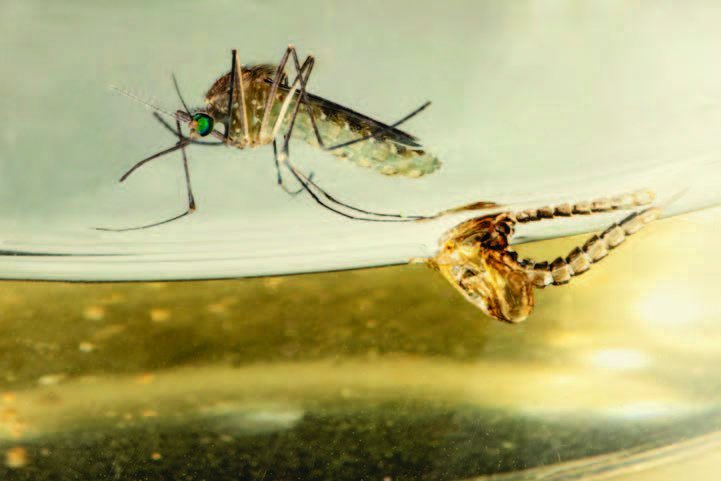 An adult mosquito emerges from its pupal case.
An adult mosquito emerges from its pupal case. Only Females Bite and Draw Blood
After emerging from their pupal cases, both male and female mosquitoes find foliage for shelter, locate plant nectar for nourishment, and mate. Only a mated female bites animals using her proboscis (beak) to penetrate the skin of any animal (including humans, horses, dogs, and birds) to get blood. Mosquito saliva contains an anesthetic that prevents us from feeling the bite.
The bite (called a “blood meal”) provides the proteins the eggs inside the female need to develop. Most humans are unaware of being bitten until the telltale, itchy raised welts appear and persist for hours to days, depending on one’s sensitivity.
Female mosquitoes can take multiple blood meals and lay many eggs in their lifetime. However, adults are rather vulnerable to adverse environments and predation. Under ideal conditions, female mosquitoes can live for several months, but normally live only six weeks. Males, on the other hand, only live for about a week. In their quest to reproduce, mosquitoes can fly fairly long distances based on the species and weather conditions (such as, wind). However, depending on species, shelter, and availability of blood meal, some mosquitoes only need to fly short distances to find everything they need. The ease with which you can find and control most of the mosquitoes on a customer’s property can vary. In some neighborhoods, mosquitoes can find everything they need to thrive in our backyards. As a result, killing mosquitoes on an individual property may be relatively easy. Conversely, reducing biting mosquitoes can be a challenge if they emerge from neighboring properties and move to your customer’s property to find a blood meal.
 A female mosquito takes a blood meal.
A female mosquito takes a blood meal. 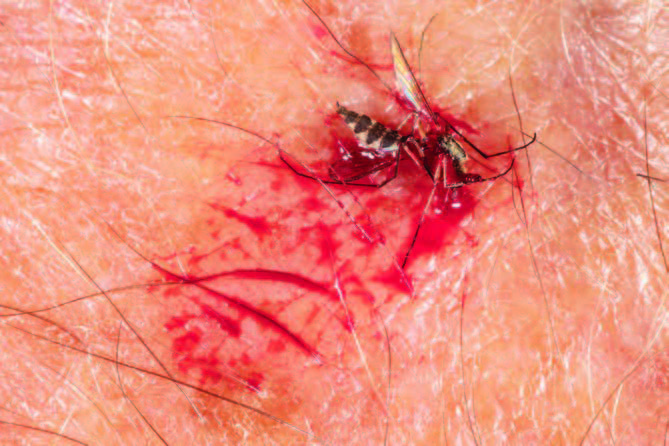 The swatted female shows how much blood it took from this unlucky victim. Mosquitoes can transmit pathogens to humans and other animals during this feeding.
The swatted female shows how much blood it took from this unlucky victim. Mosquitoes can transmit pathogens to humans and other animals during this feeding. 
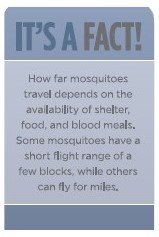
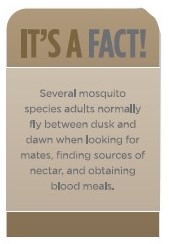
Adults Look for Shelter
Several adult mosquito species normally fly between dusk and dawn to look for mates, find sources of nectar, and obtain blood meals. Females need a cool, moist habitat to rest in during the day when they are not actually seeking a blood meal.
These locations, known as “harborage sites,” protect them from the environment and predators. Common harborage sites include the undersides of foliage, sides of storm drains, eaves on houses, undersides of porches, and on shed walls. These protected areas allow mosquitoes to rest, digest the blood meal, avoid sunlight, and stay dry. Since mosquitoes do not regulate their internal temperatures, they need to find harborage sites that can keep their bodies at optimum temperatures. Why is it so important to know about favorable adult mosquito harborage sites? The answer is simple.
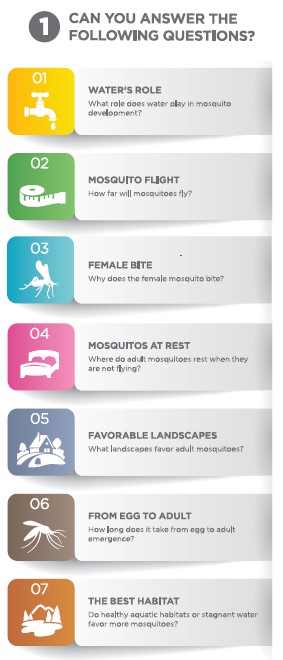
Knowing harborage sites directs you where to treat and where not to treat on your customer’s property. Landscaped properties contain so much foliage and standing water that mosquitoes have expanded from their natural habitats of surrounding forests and marshes to rest within a residential property and to be nearer to people and the blood meals they provide.
Mosquitoes will not rest in places that do not protect them from direct sunlight, high temperatures, and water loss (such as mowed lawns, concrete driveways, playground equipment, and building surfaces exposed to direct sunlight). Should you treat concrete surfaces and short grass? No! Should you treat the undersides of foliage and under low-lying decks? Yes! It could also violate labels to treat concrete and other impervious surfaces with the insecticides.
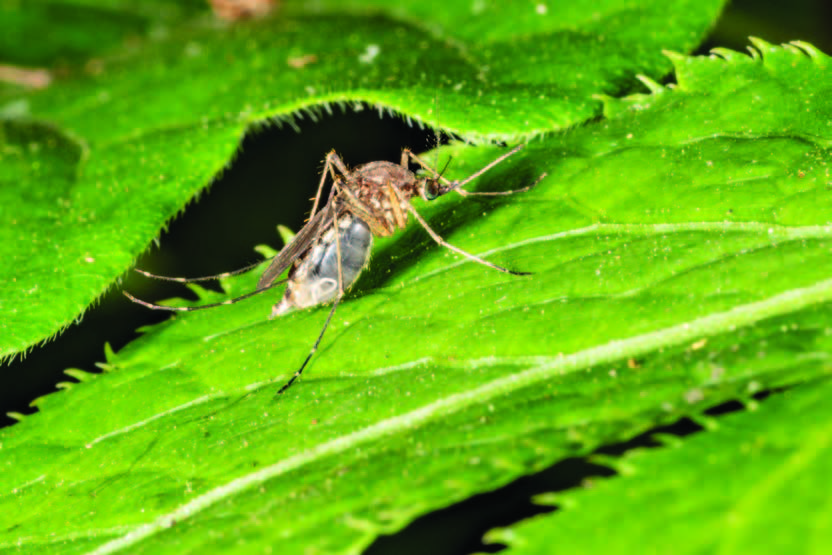 A female mosquito rests amongst leafy vegetation in a harborage site. Female mosquitoes can be distinguished from males by their lack of hairy antennae.
A female mosquito rests amongst leafy vegetation in a harborage site. Female mosquitoes can be distinguished from males by their lack of hairy antennae. 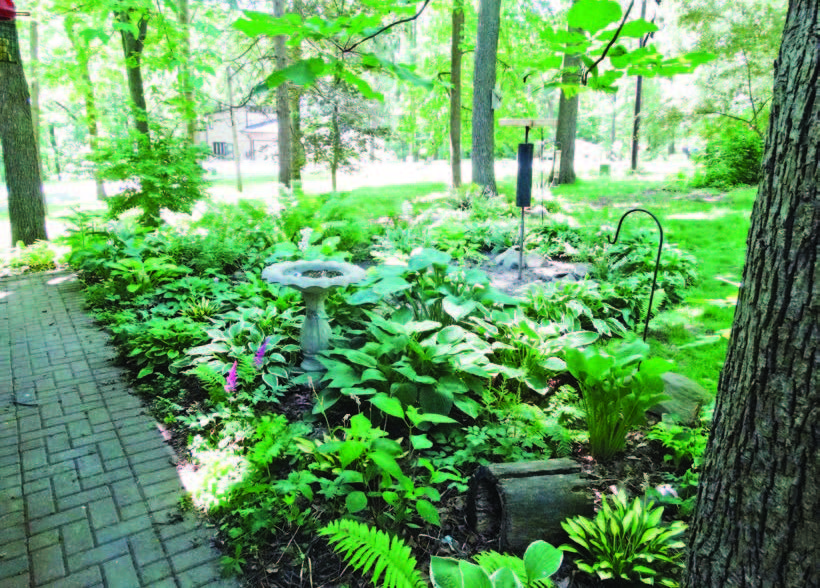 Landscapes that provide plenty of shade, water, food, and hiding places allow mosquitoes to reproduce in large numbers.
Landscapes that provide plenty of shade, water, food, and hiding places allow mosquitoes to reproduce in large numbers. 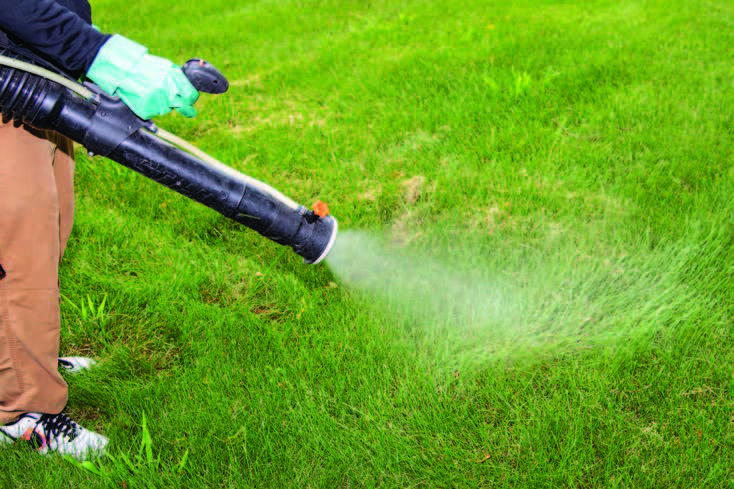 Applying insecticides into managed turf wastes material and time because adult mosquitoes do not find this a suitable habitat.
Applying insecticides into managed turf wastes material and time because adult mosquitoes do not find this a suitable habitat. 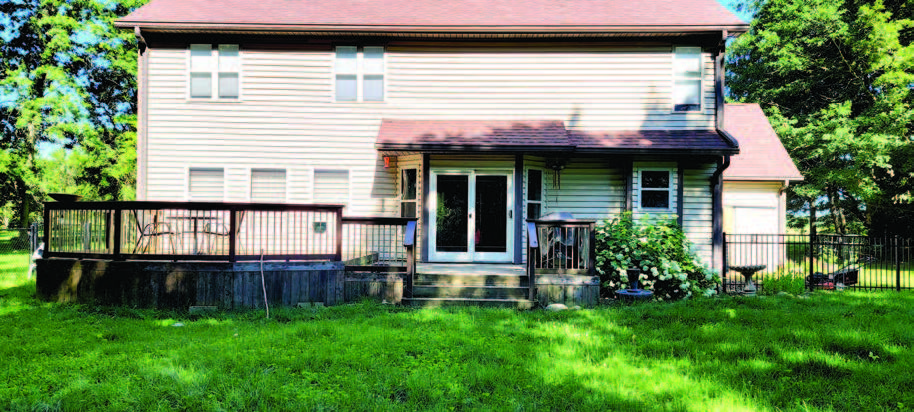 Adult mosquitoes can find suitable resting places under decks.
Adult mosquitoes can find suitable resting places under decks. 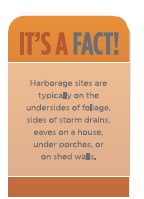
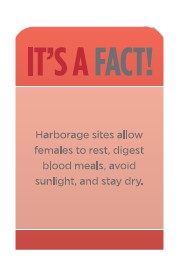
TURNING DOWN CUSTOMER REQUESTS FOR MOSQUITO TREATMENTS
The commercial mosquito control market continues to expand. With that expansion will come inquiries from customers who want mosquito management services on landscapes without water, foliage, and suitable harborage sites. Look at the following photographs. Based on what we now know about mosquito biology, which one of the homes would be a poor candidate for a mosquito control application?
The honest answer is that you may not be able to control mosquitoes on the first property no matter how
much you spray.

This residential lot shows no signs of harborage sites, no water sources, and no protective shade. On inspection, all you see is mowed grass and a concrete driveway, both in full sunlight. The only possible explanation on why residents are experiencing mosquito bites is that the adults are originating from neighboring properties; nearby woods, marshes, and wetlands; temporary pools of water alongside ditches; or sewage effluent. Let us assume for a minute that you do not believe that assessment.
 This property has too much sun, too little shade, and too few harborage sites to be attractive to adult mosquitoes. However, the shaded sides of buildings, under homes, cool sheds, and other areas may contain mosquitoes. Even in a sunny yard, there could still be areas that could be potentially treated.
This property has too much sun, too little shade, and too few harborage sites to be attractive to adult mosquitoes. However, the shaded sides of buildings, under homes, cool sheds, and other areas may contain mosquitoes. Even in a sunny yard, there could still be areas that could be potentially treated.  This property has plenty of shrubbery that will provide ideal harborage sites and shade for mosquitoes.
This property has plenty of shrubbery that will provide ideal harborage sites and shade for mosquitoes. 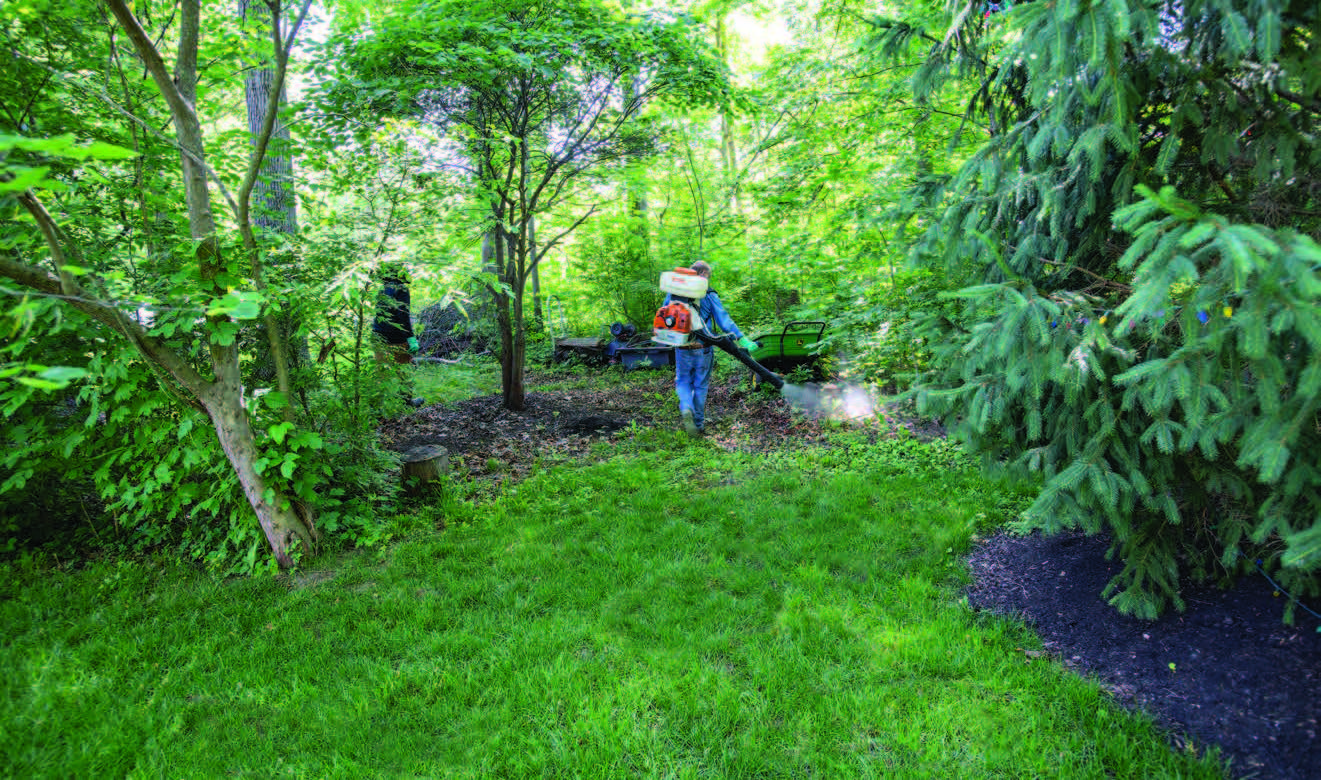 Left untreated, these woods could harbor enough mosquitoes to affect not only the property owner but adjacent properties as well.
Left untreated, these woods could harbor enough mosquitoes to affect not only the property owner but adjacent properties as well. Where would you make an insecticide barrier application to bring the product in contact with resting mosquitoes? Barrier applications, also referred to as “perimeter sprays,” are applied to areas where mosquitoes rest. But how can a barrier treatment work if all the property has is grass, concrete porches, and a couple of small trees? The answer is: the treatment cannot.
Without water sources and little to no harborage, applying a barrier insecticide will be about as effective as if you had done nothing at all. Under such circumstances, consider recommending that owners contact their county health departments to make them aware of the mosquito problems they are having. There may be public or abandoned areas that municipalities or counties could treat to reduce the influx of mosquitoes on individual properties and neighborhoods.
Another thing to consider is that mistaken identity may lead homeowners to think mosquitoes are biting family members. Other insects (including biting flies, midge flies, and crane flies) may be short-lived during periods of heavy, repeated rainfalls. In addition, an outbreak of fleas inside the home may be what is biting the occupants rather than the flying insects seen outside.
In short, some homeowners are very “bug” averse and may have poor understanding of insects, spiders, mites, millipedes, and so on. Although mosquito treatments are unnecessary, these may be educational opportunities that can lead to long-term customers for in-home or outdoor pest control.
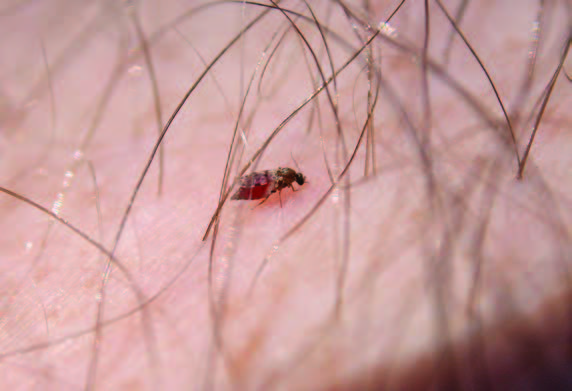 A biting fly engorges on human blood.
A biting fly engorges on human blood. 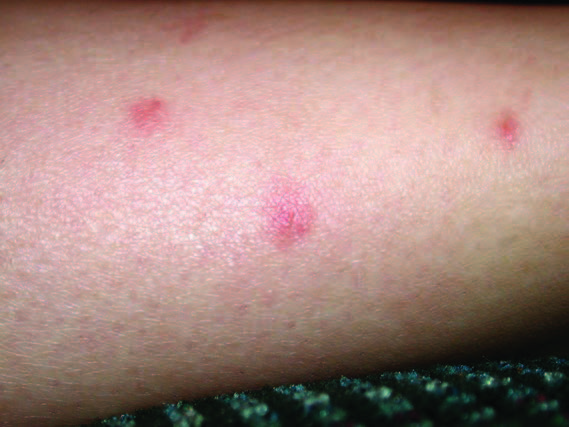 The welts produced from those bites.
The welts produced from those bites. RESIDENTIAL TREATMENTS AIM TO REDUCE BITES, NOT PREVENT DISEASES
While calls may go up when mosquito-borne diseases hit the news, we must be careful not to make disease prevention claims about our services. The primary focus of residential treatments is pest control, not vector control. While it may seem like a subtle distinction, the differences are great. There are more than 200 mosquito species that live in the United States, but only about a dozen of them can transmit diseases to humans. Those 200 different species also have different behaviors, such as breeding site preference, the time of day in which they bite, and even what they feed on.
Often, the annoying buzzes and bites from mosquitoes that prevent our customers from enjoying their backyards are not capable of transmitting disease. Therefore, targeting those mosquitoes does nothing to prevent diseases. More important, the prevalence of many mosquito-borne diseases (such as West Nile virus) builds as the season progresses. That does not mean our treatments early in the mosquito season are less valuable than later ones.

Backyard mosquito control is intended to reduce the amount of biting mosquitoes in an outdoor space so that customers can enjoy their backyards. This is about improving the enjoyment of our yards, not reducing the threat of vector-borne diseases. How can we make public health claims when many of the mosquitoes we target cannot transmit diseases in the first place? Sure, we may kill a few disease-vectoring mosquitoes in the process, but companies should choose their words wisely and focus their sales and advertisements on the message that their treatments can reduce biting mosquitoes and enhance their customer’s ability to enjoy their outdoor spaces.

The plants around this outdoor patio can be a harborage area for biting mosquitoes.
HAVE A PLAN BEFORE STRAPPING ON YOUR BACKPACK MIST BLOWER
Does an automobile mechanic open the hood to start repairs without first investigating what the problem is? Of course not. Mechanics run a series of diagnostic tests to pinpoint the sources of problems. So, why would you ever turn on the mist blower and start treating a residential property sight unseen?
Before you begin any treatment, you should take a brief walk around the property to get an overview of the situation. It’s even better if you can convince customers to accompany you in your assessments of their property. These walkarounds are your chance to enlist their help in making your treatments more successful by pointing out potential mosquito breeding sites, educating them about keeping overgrown foliage trimmed, and telling them about the importance of emptying any accumulated water.
The first thing to look for during an assessment is to find the shady areas and any standing water. Harborage areas might include shrubs near the home, the undersides of raised shaded porches, privacy plantings, and similar thickly vegetated areas.
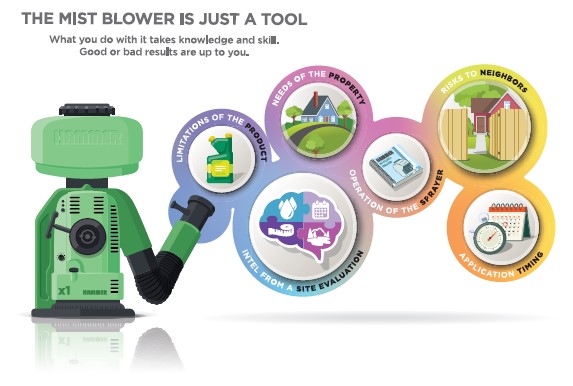
The second phase of a fact-finding assessment is to identify those sensitive areas where you do not want to spray an insecticide. Areas that contain toys (for children or pets), swing sets, flower boxes, and outdoor kitchens are all areas you must avoid. It’s also important to avoid blooming plants, which attract beneficial pollinator insects. Most, if not all, mosquito-control products have very specific instructions to avoid harming pollinators, such as bees and butterflies. Examine the photographs for potential harborage sites and no-spray zones.
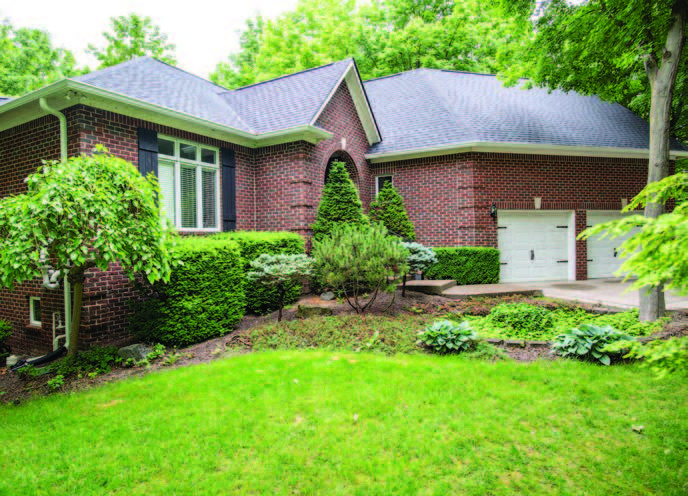
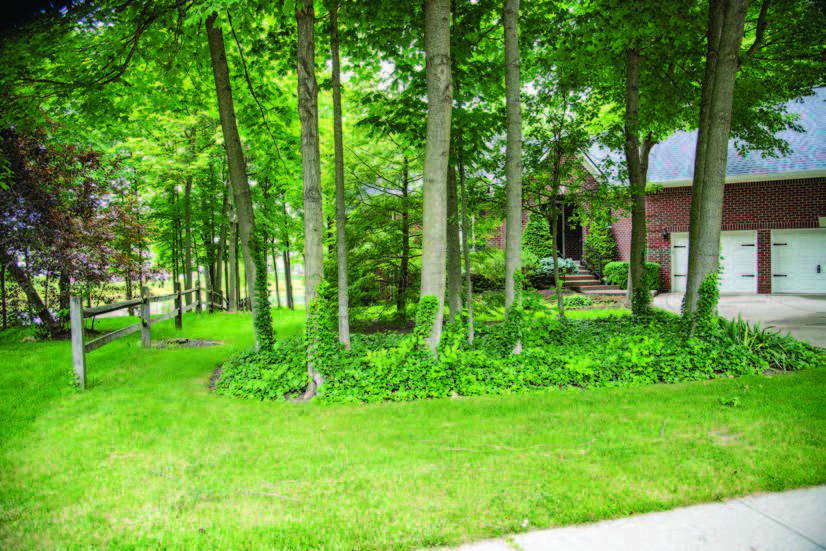
Community residents use the area across the fence. What might be some issues with this site when treating the customer’s property for mosquitoes? What if you saw a swimming pool, a pet, or beehive?
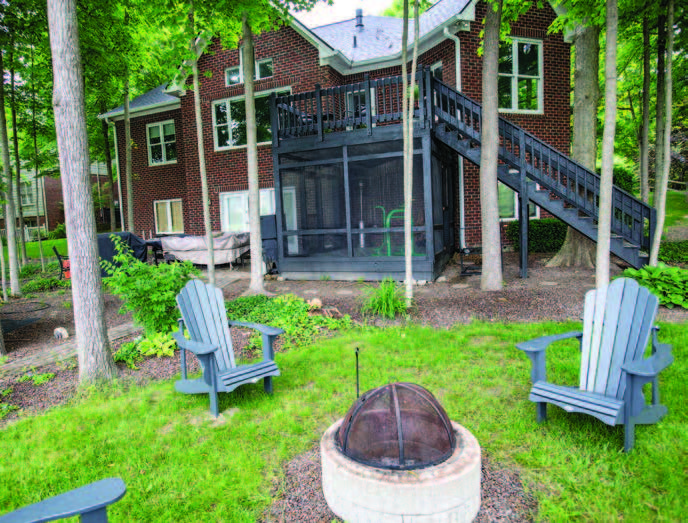
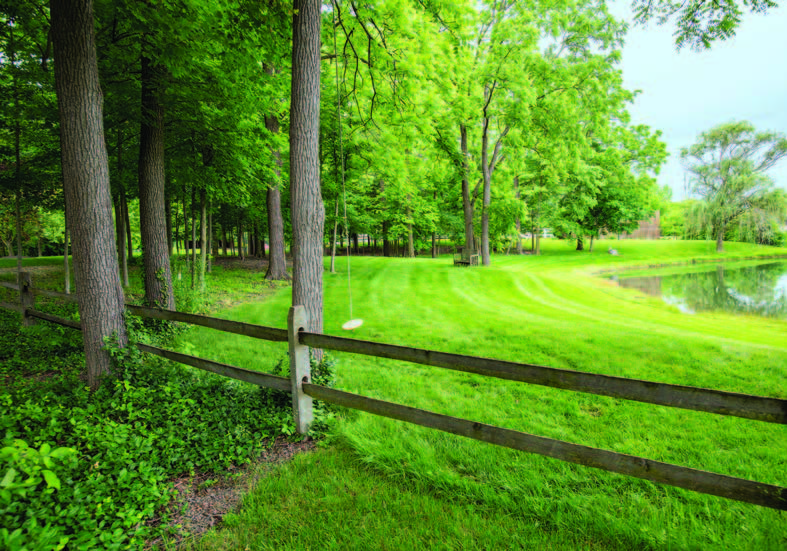
If you want to go the extra mile, look over the “fence” to see what concerns you might have about potential complaints from neighbors who might not want any part of your application on their property. Concerns might include their pets left outdoors, large flower beds, vegetable gardens, beehives, koi ponds, and swimming pools.
Once you note concerns, apply insecticides away from neighboring properties to keep the neighbors happy. You do not want to inadvertently start a war between neighbors, which is why it is wise, if possible, to create a barrier between the two properties. For future treatments, know that you should not treat client properties on windy days if they have “chemical-sensitive” neighbors.
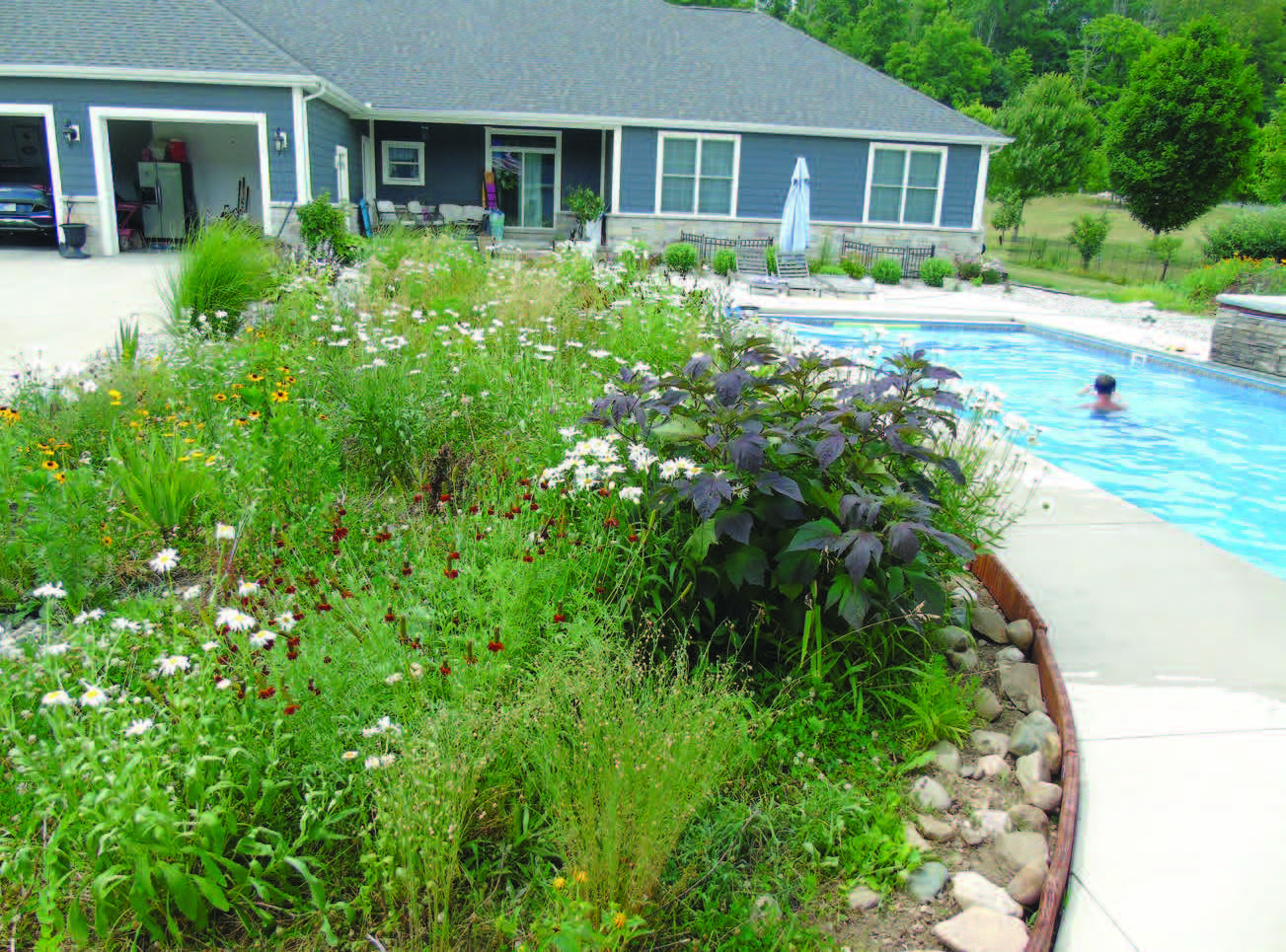 A neighbor’s pollinator garden and swimming pool next to your customer’s property will require special attention when making an application with a backpack mist blower.
A neighbor’s pollinator garden and swimming pool next to your customer’s property will require special attention when making an application with a backpack mist blower.  Homeowners might be unaware their gutters are clogged. Point it out if you see it. Broken gutters can be full of standing water and a major source of biting mosquitoes.
Homeowners might be unaware their gutters are clogged. Point it out if you see it. Broken gutters can be full of standing water and a major source of biting mosquitoes. 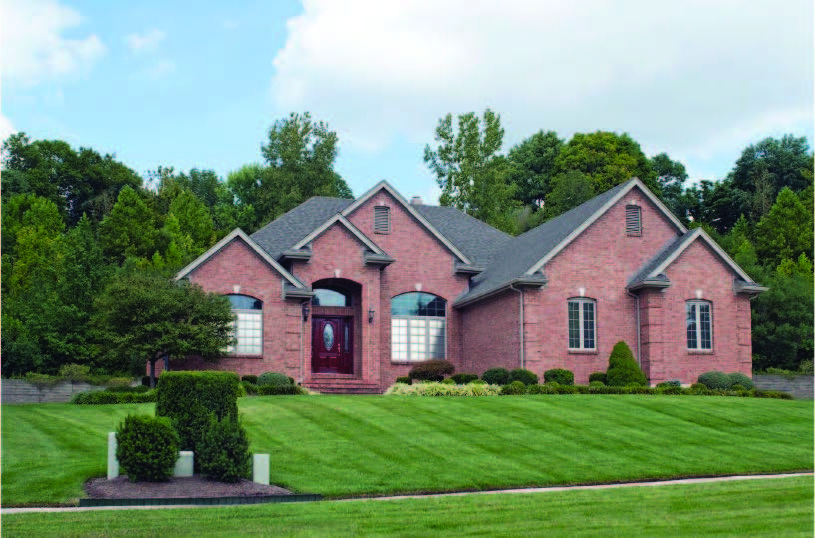 Walking the property only takes a few minutes, but it helps identify places where mosquitoes are resting and need treatment. It also reveals areas, such as locations with blooming plants, that you should not spray.
Walking the property only takes a few minutes, but it helps identify places where mosquitoes are resting and need treatment. It also reveals areas, such as locations with blooming plants, that you should not spray. It only takes 5 to 10 minutes to perform a site assessment on a 10,000 square foot property, but that assessment can tell you a lot about where to treat or not to treat if it is your first visit to the property. If you have previously been on the site, a new assessment will tell you if anything has changed since your prior visit. By the time you strap a backpack mist blower to your back, you will know the layout of the property, where the harborage sites are, and the areas to be left untouched. This assessment will be the best 5-minutes you spend on the property because it will make for a more complete, effective, and safer application. Additionally, the customer will perceive your thoroughness, which may build trust and could translate into value and retention. A few minutes up front will save hours, weeks, and perhaps months of dealing with follow-ups from poor control or paperwork with drift complaints from upset neighbors.
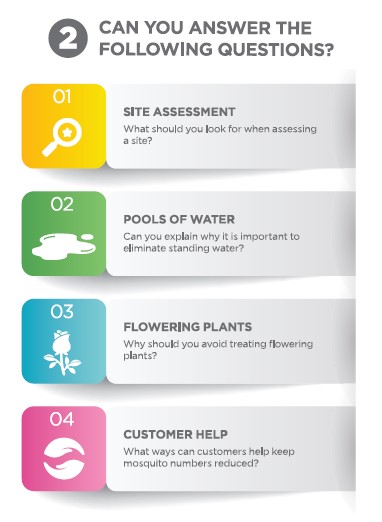
WATER, WATER EVERYWHERE
Larvae and pupae do not have gills like fish that obtain their oxygen directly from the water. Mosquito larvae and pupae obtain their oxygen from the air. Both larvae and pupae have modified structures that penetrate the surface of the water to access the air they need to breathe. This brings us back to the importance of eliminating standing water. Since larvae and pupae breathe air from the surface, they can live in water with organic matter and that has such low levels of oxygen that fish cannot survive.
Water standing in a bucket or tire outdoors in warm weather is attractive for female mosquitoes to lay eggs. Such places are also a brewery for microorganisms that mosquito larvae feed on.
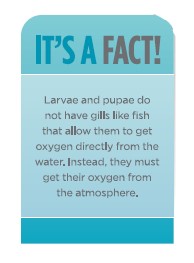
Water collected in a single discarded tire can breed 10,000 to 500,000 mosquitoes over the course of one season. Combined with other stagnant water sources, it is not hard to imagine how many adult mosquitoes could be pouring into a customer’s yard over the course of one season.
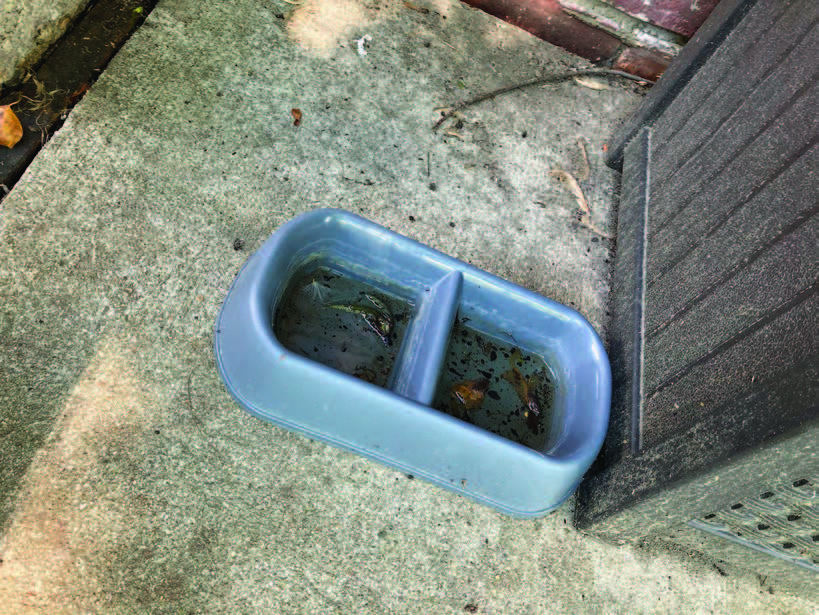
It does not take much water for mosquito larvae to survive.
Why should mosquitoes go down the road when “tasty” blood meals (in the form of your customers) are immediately available? Adulticiding alone will not effectively control mosquitoes in areas where there are multiple potential breeding sites.
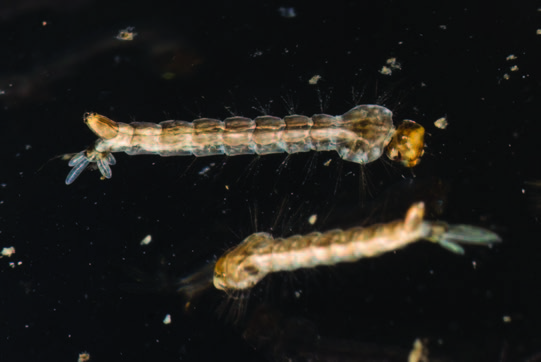
Larvae obtain oxygen from the atmosphere through a siphon that breaks the water surface.
You should remind customers that they have a role in reducing the number of biting mosquitoes around their property. Our goal is to always stop mosquito reproduction onsite by eliminating as much standing water as possible. Eliminating breeding sources (such as standing water in old buckets or flowerpots) when combined with adulticiding creates the one-two punch you need to successfully control mosquitoes
on customers’ properties.
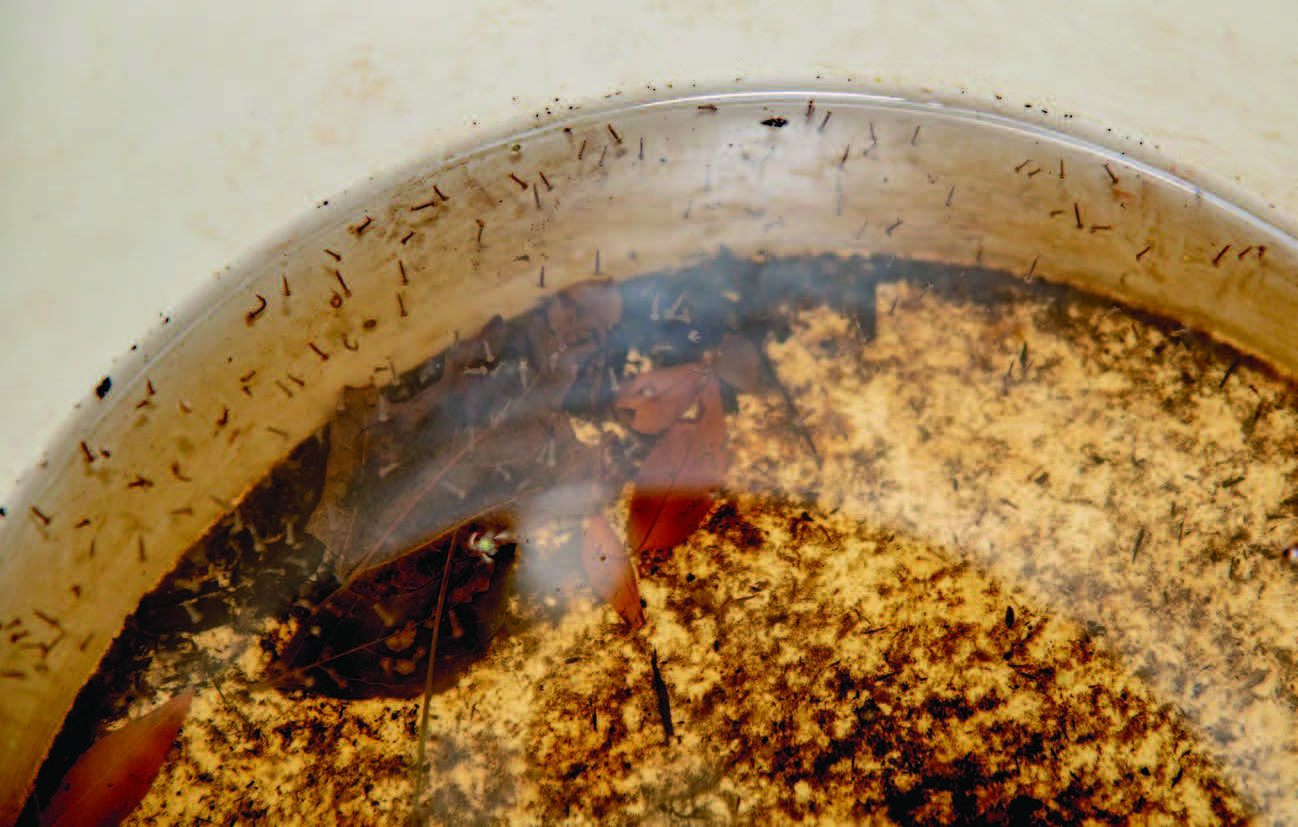 This plastic bucket holding leaves and other organic materials provides mosquito larvae a perfect habitat. As long as the water remains, female mosquitoes will continue laying eggs and producing future generations.
This plastic bucket holding leaves and other organic materials provides mosquito larvae a perfect habitat. As long as the water remains, female mosquitoes will continue laying eggs and producing future generations. 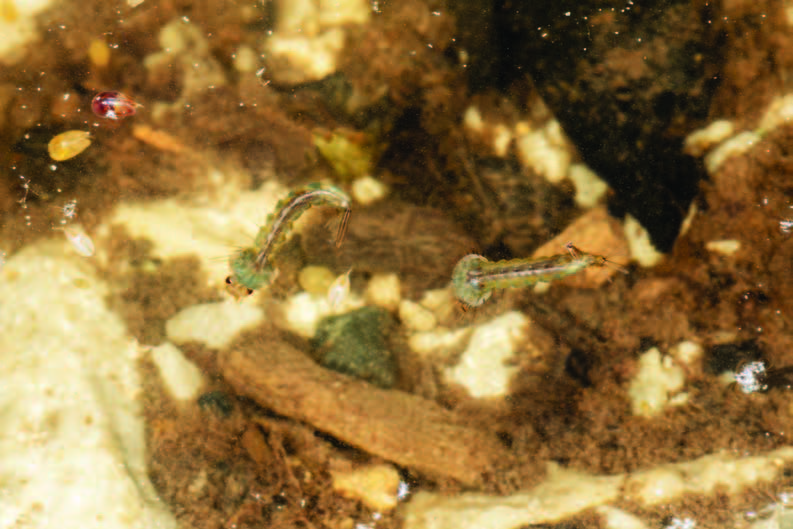 close up of the larva in plastic bucket
close up of the larva in plastic bucket 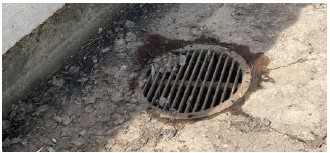 This stormwater runoff drain keeps excess water from building-up in wet weather, but it may never completely dry even under drought conditions. There is always some stagnant water that provides for excellent mosquito resting and breeding areas.
This stormwater runoff drain keeps excess water from building-up in wet weather, but it may never completely dry even under drought conditions. There is always some stagnant water that provides for excellent mosquito resting and breeding areas. 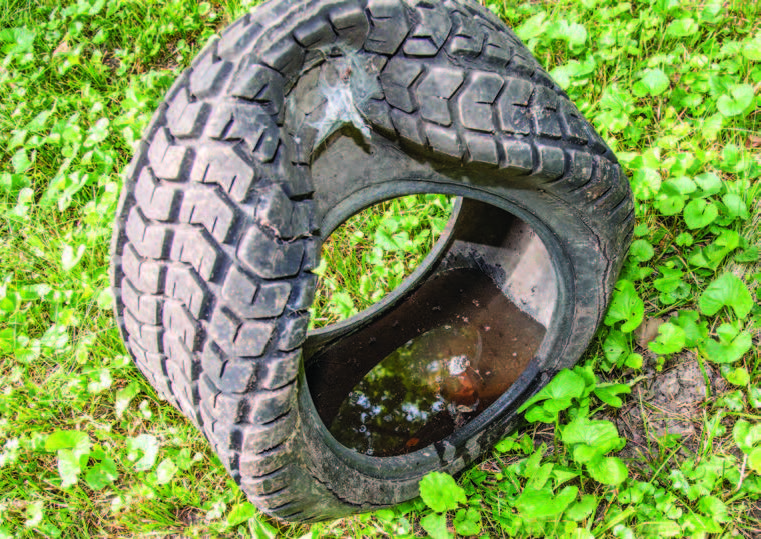 Tires also help mosquitoes survive the winter and ready to reemerge in the spring to ruin someone’s backyard enjoyment.
Tires also help mosquitoes survive the winter and ready to reemerge in the spring to ruin someone’s backyard enjoyment. GRILLING MOSQUITOES UNDER THE DECK
One applicator shares a learning experience that shows the importance of removing standing water as part of an overall residential mosquito control program. “A customer reported the mosquito problem was as bad as it was before the insecticide treatment. I
told him that did not make sense, as the counts in the neighborhood were extremely low. I told him I would come on over and see for myself, but I had my doubts about his story. “He took me to the back porch where he was being bitten. While I was there, I said to myself that the mosquitoes were as bad as what the customer had indicated on the phone.

“I happened to notice that the porch was new. The customer told me he was proud of his new porch, but he had to clean it frequently to wash off the dirt and leaves. I looked underneath the porch and saw what looked like an old grill. I asked the owner, ‘Is that your old grill?’ He answered, ‘When I got the new porch, I got the new grill.’ I asked him if I could pull it out, thinking it might possibly be the problem. “My assumption was right. The grill was full of water and rotten leaves. It was breeding tons and tons of mosquitoes and was, more or less, a cesspool of mosquitoes. We dumped the grill, and the problem was immediately solved.”
Do your part in educating customers about what they need to do about removing standing water from gutters, buckets, tires, bird baths, and flowerpots. Most customers are oblivious to the fact that mosquito larvae can do well in any container that holds water for a week or so. Let them know that most of these containers need to be emptied and turned over or stored to prevent future mosquito breeding. Remember: A week is about all the time mosquitoes need to grow from egg to adult. The same water source that a female emerged from can be attractive when it is time for her to lay eggs.
For sites such as buckets and flowerpots, emptying them once and turning them over is suffcient. However, shallow bird baths and some water features should have their water changed several times a week. An often-overlooked source of standing water is improper drainage between or around houses or uneven ground that retains water for extended periods. Watch for these, especially in new housing developments.
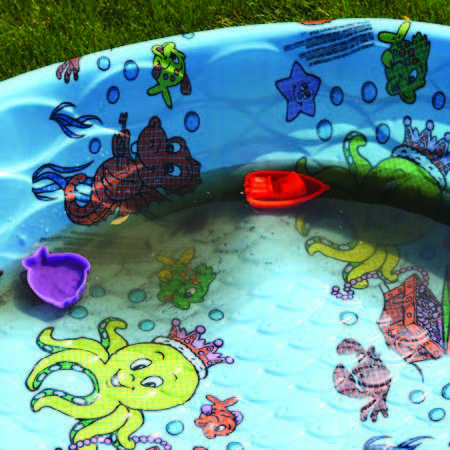 Reducing water sources is one of the more important components for managing adult mosquitoes.
Reducing water sources is one of the more important components for managing adult mosquitoes. 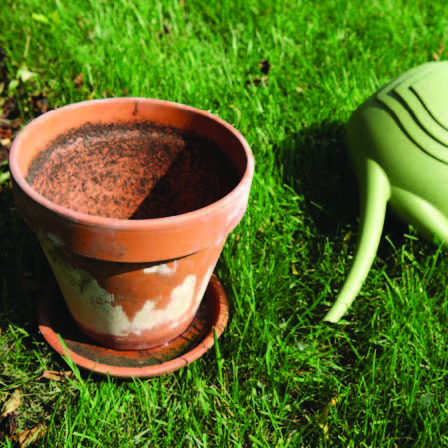
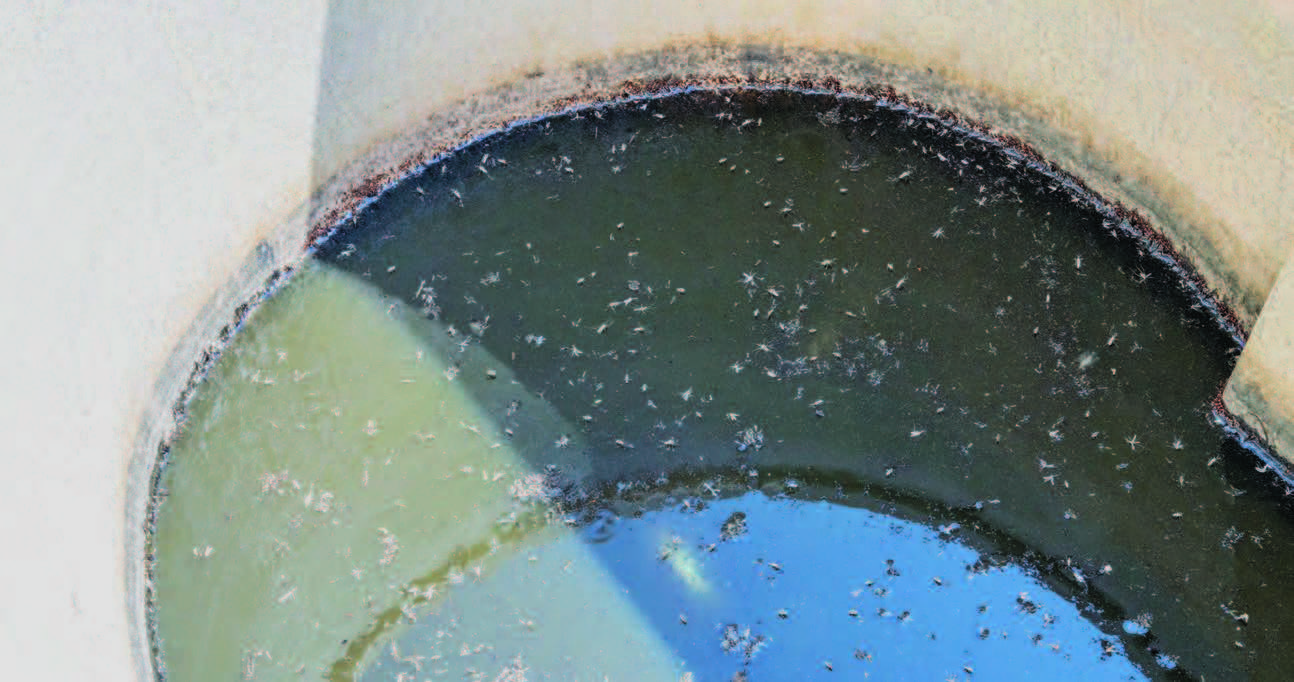 Look closely at the stagnant water and you will see shed skins floating on the surface, left behind by mosquitoes after emerging from their pupal cases.
Look closely at the stagnant water and you will see shed skins floating on the surface, left behind by mosquitoes after emerging from their pupal cases. 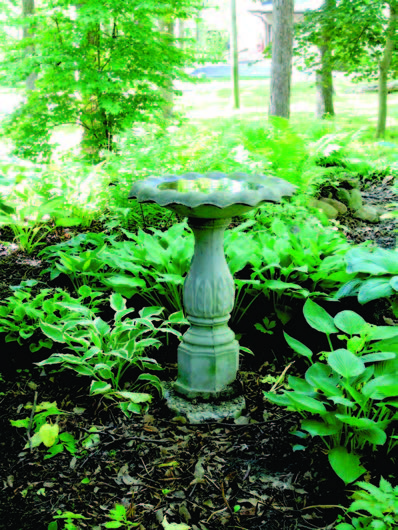 Property owners should change the water in bird baths a couple times a week, because they are very attractive to female mosquitoes.
Property owners should change the water in bird baths a couple times a week, because they are very attractive to female mosquitoes. 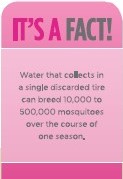
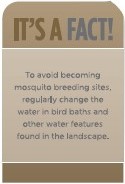
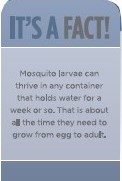
While it takes time, another opportunity for educating customers is a “show-and-tell” demonstration. Such a demonstration is one more reason to get customers to follow you on the inspection. By showing customers containers from their property that contain larvae, you are sure to get their attention and hopefully spur them to action.
Some might think that showing customers how to eliminate breeding sites on their properties would lead to them cancelling your service. However, working with your customers will just as likely improve your chances of retaining them because of the trust you are building. Furthermore, you would gain more interest from their neighbors as word-of-mouth spreads. Besides, there are enough non-participating neighbors to reinfest mosquitoes to require future treatments.
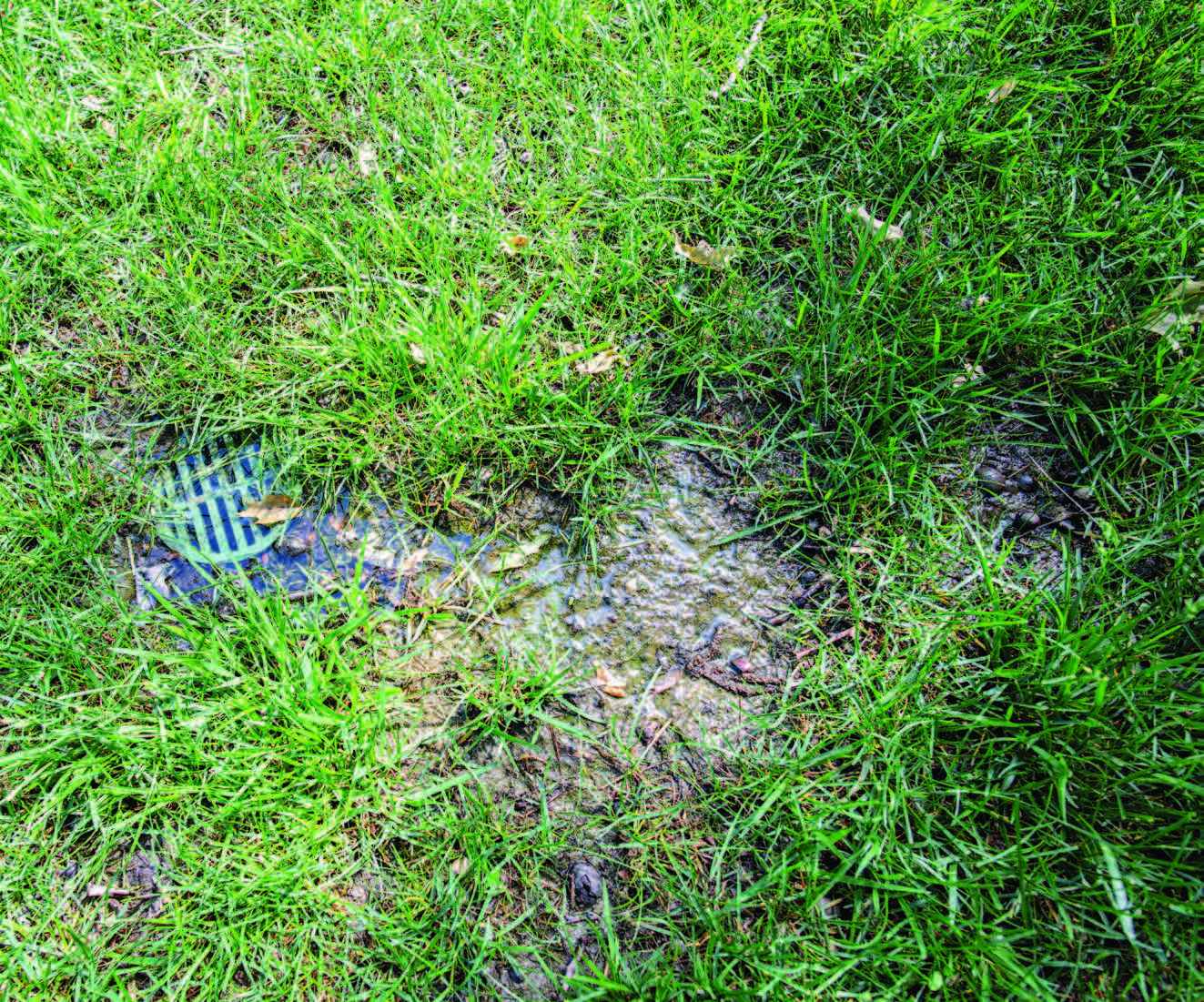
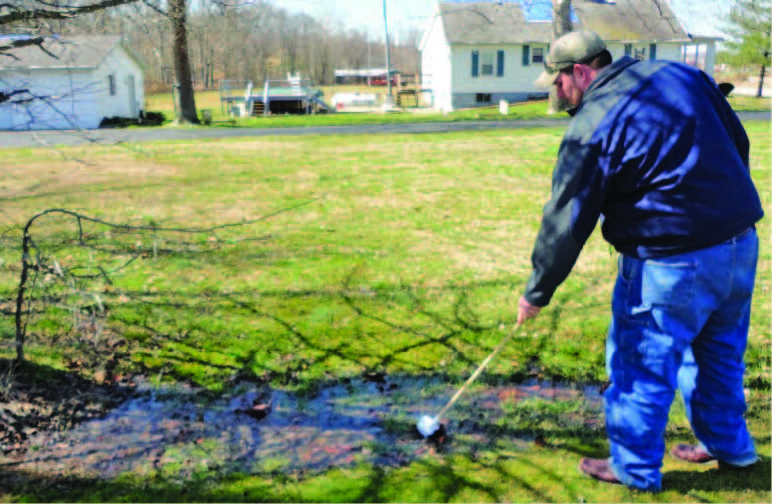
multiple generations of mosquitoes that can reinfest a property.
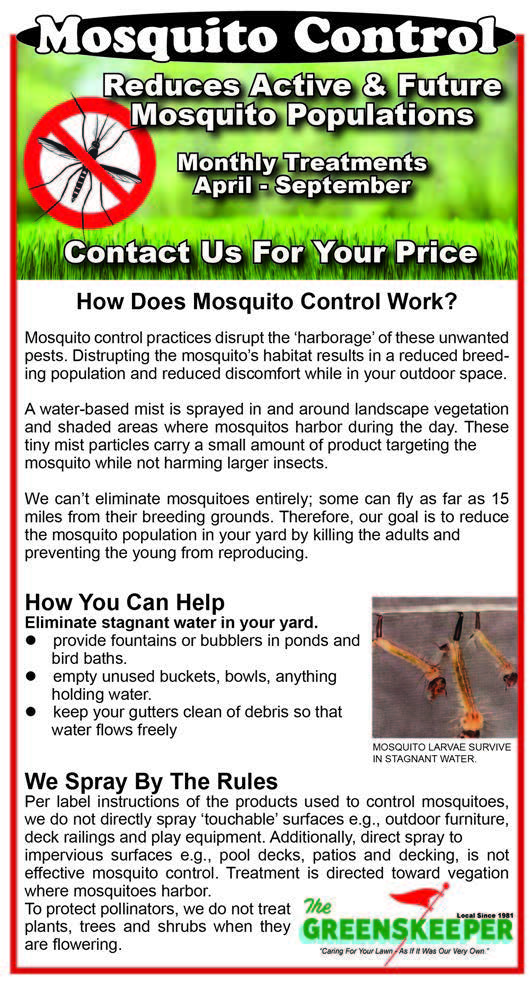
and ways that property owners can reduce mosquito harborages.
THE ONLY SWIMMERS IN THE SWIMMING POOL WERE MOSQUITO LARVAE
Here is a pest management professional’s account of one breeding site he encountered. “We were asked to treat a property to keep their guests comfortable when hosting a backyard function. The treatment was a great success and those attending had a wonderful time at the party. Seven days later, the customer complained that the mosquitoes had regained control over the backyard. Adult counts in the area were not high at all and no other customers were complaining.
“I visited the site and quickly saw that the kiddie pool was not there. I asked the customer what had happened to the pool. He indicated that it had been disassembled and stored outdoors at the back of the shed. I walked around to where it was and saw the pool had about 2 inches of water in it. It only took a few minutes to look at the thousands of larvae, pupae, and adult mosquitoes emerging from the pool. The reason the treatment was not lasting any longer than it was, was because the pool had become the center of the breeding zone. It didn’t matter where the barrier was, as the females looking for a blood meal went from the pool to people.”
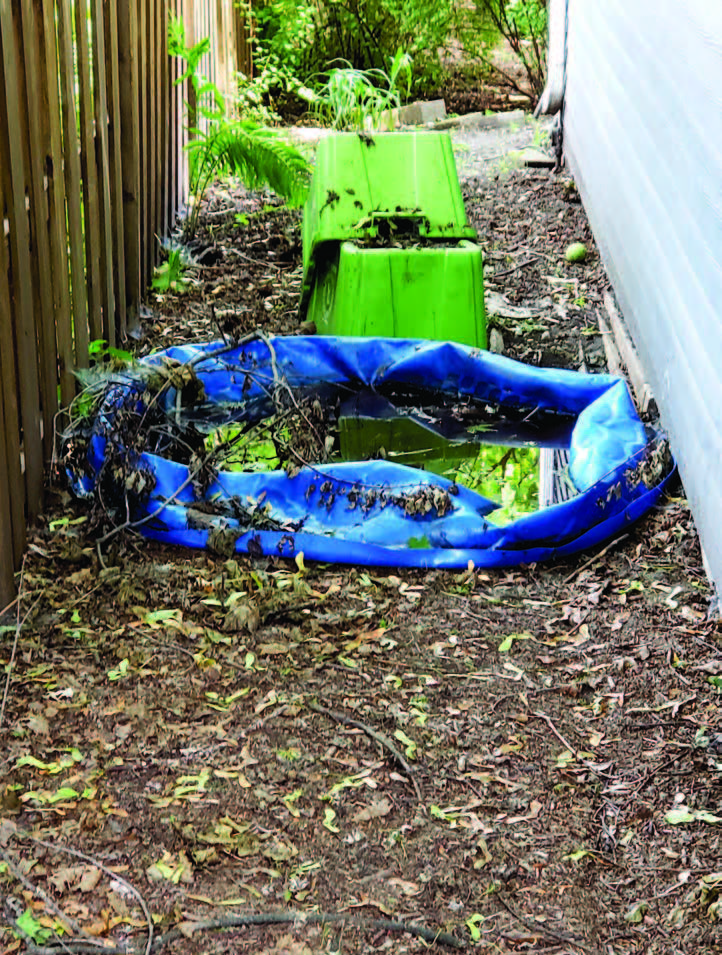
This is why you look behind someone’s shed during your property inspections. Everything that doesn’t fit in the shed, or they don’t want ends up here — from old tires (that could have been there for years), to plastic buckets, planters, and thousands of objects that could hold water.
TREATMENT METHODS AND CONSIDERATIONS
There are three viable options you can use to reduce mosquito numbers on residential properties: barrier treatments, water removal, and larval control. The two most common approaches include applying adult insecticide products to harborage sites and reducing accumulated water in containers — this is the one-two punch we mentioned earlier. Depending on the property, a third option is applying larvicide to areas that contain standing water that cannot be drained, such as low-lying areas, culverts, and pond edges.
Barrier Treatments for Adult Mosquitoes
Businesses that offer adult mosquito control services use backpack mist blowers to apply small droplets of insecticide to foliage, including the undersides of vegetation where mosquitoes rest during the day. These insecticides are mainly synthetic pyrethroids, which are fast-acting, have good residual efficacy by remaining on the leaf for an extended period, and have a lower toxicity to mammals (this includes you) than some other classes of insecticides. However, pyrethroids can also reduce beneficial insects such as pollinators (which is why you do not spray flowers in bloom), can be toxic to fish (which is why you don’t apply to water), and a few applicators can develop a skin sensitivity (which is why you must wear clothing and personal protective equipment that covers your skin).
The approach for backyards with lots of vegetation is to apply the insecticide so it forms a barrier (like a wall or fence) around the property. This method should kill the mosquitoes already there and stop others from using your customer’s property as a resting site. The key to creating an effective and long-lasting barrier around a property is combining a proper application technique with a product that meets the three requirements: effectiveness, repellency, and longevity.
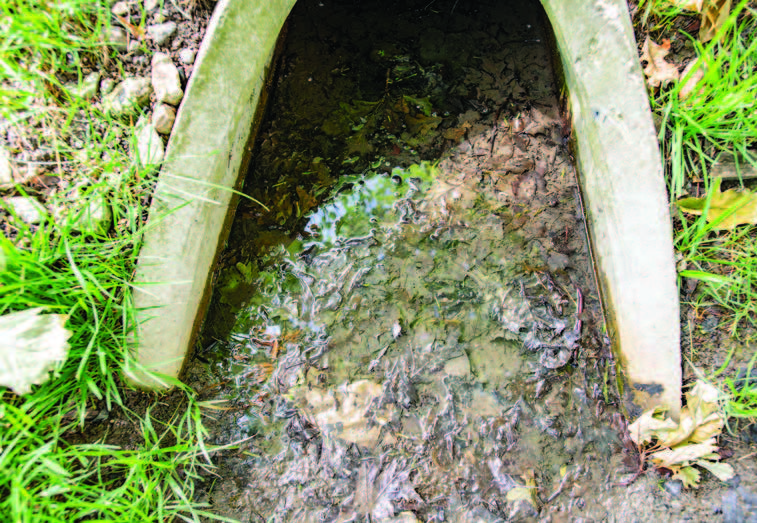
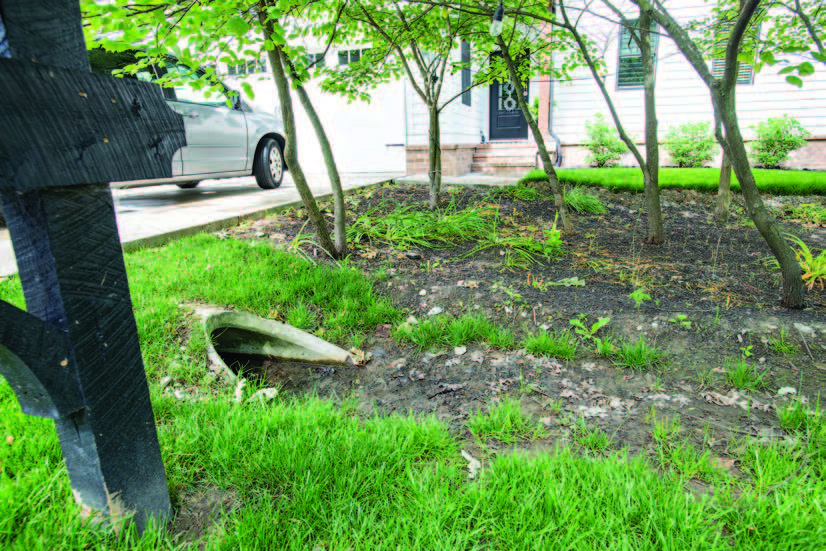 This is a perfect mosquito breeding site. Applying larvicide in this location would offer some relief from breeding mosquitoes. The larvae will consume the material, and then die, which reduces the next generation of adult mosquitoes.
This is a perfect mosquito breeding site. Applying larvicide in this location would offer some relief from breeding mosquitoes. The larvae will consume the material, and then die, which reduces the next generation of adult mosquitoes. 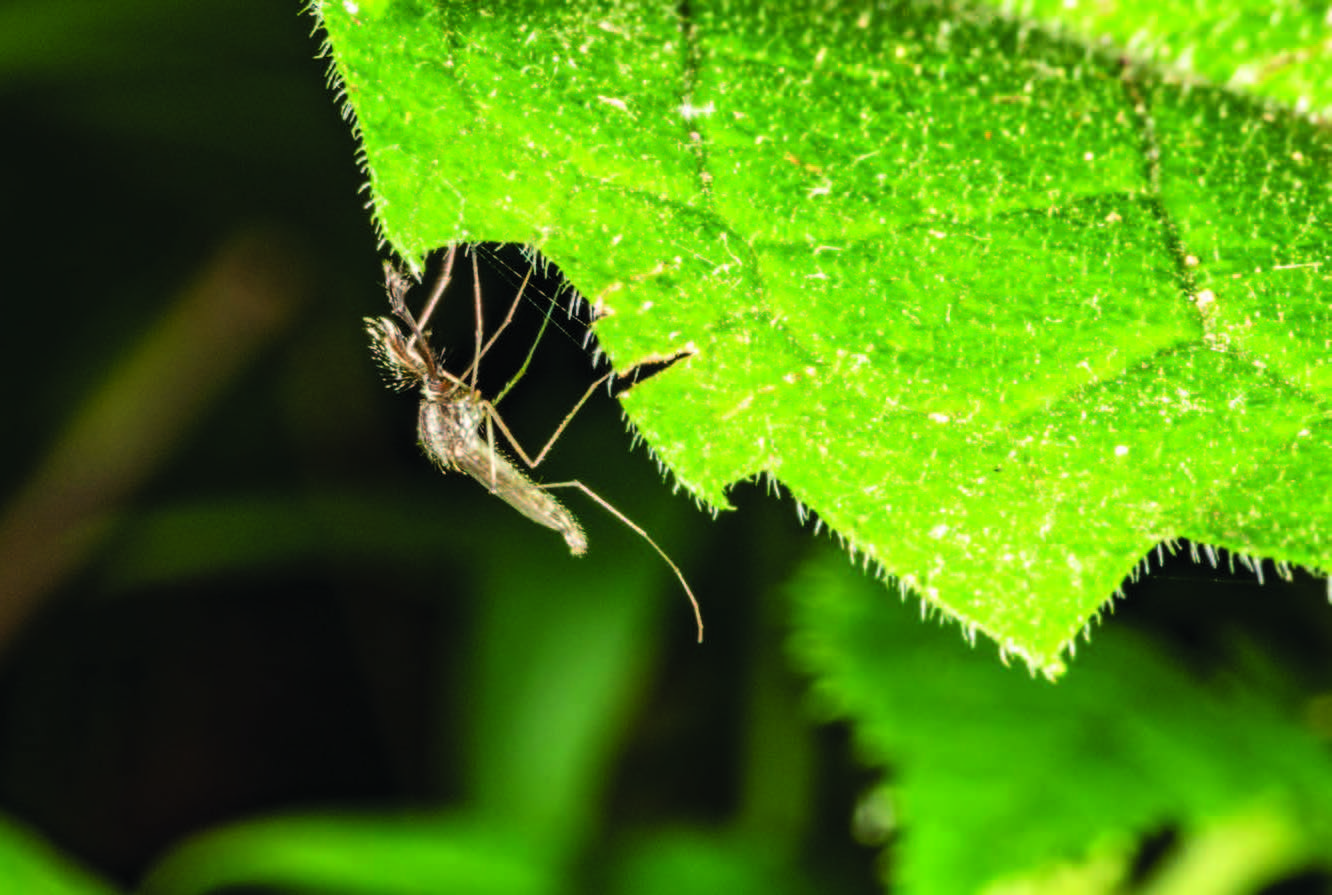 You can distinguish male mosquitoes from the females by their hairy antennae, which are used to pick up sex- attractant pheromones from females.
You can distinguish male mosquitoes from the females by their hairy antennae, which are used to pick up sex- attractant pheromones from females. 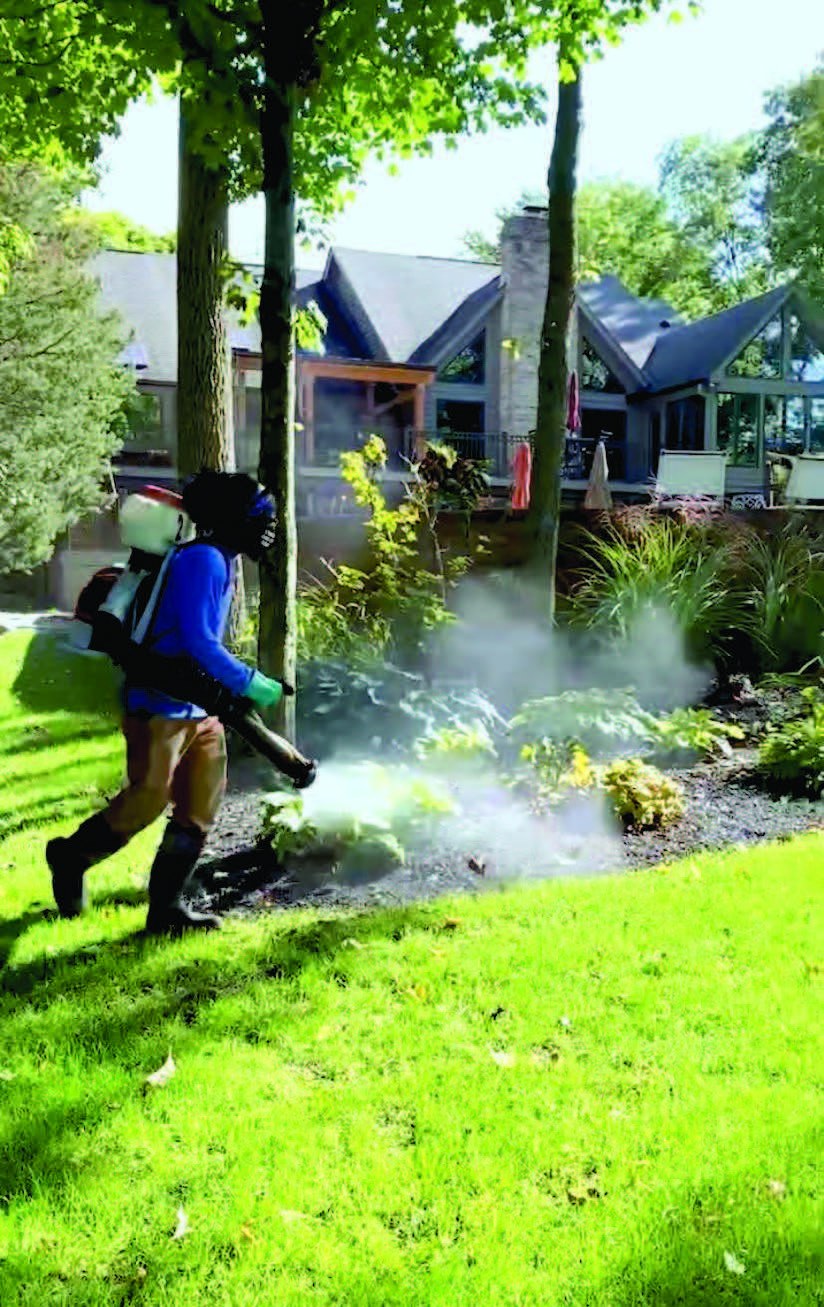 Barrier treatments aim to put product where adult mosquitoes are currently resting or will be in the future.
Barrier treatments aim to put product where adult mosquitoes are currently resting or will be in the future. 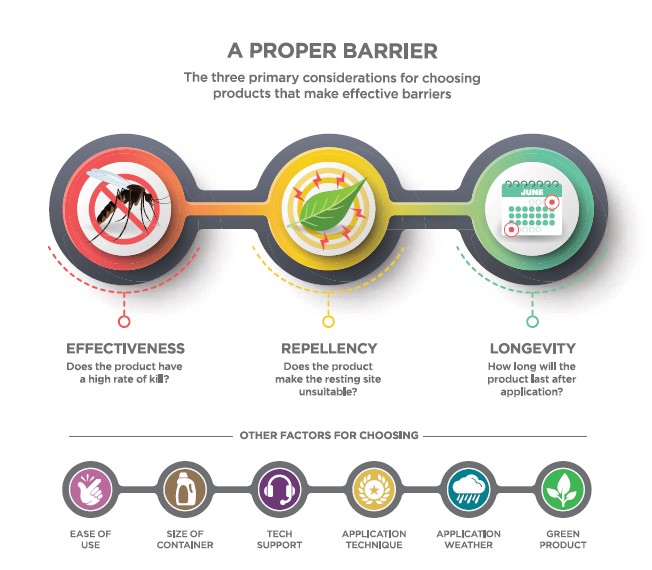
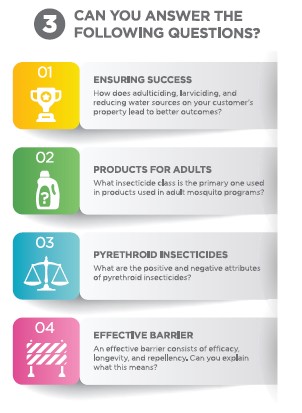
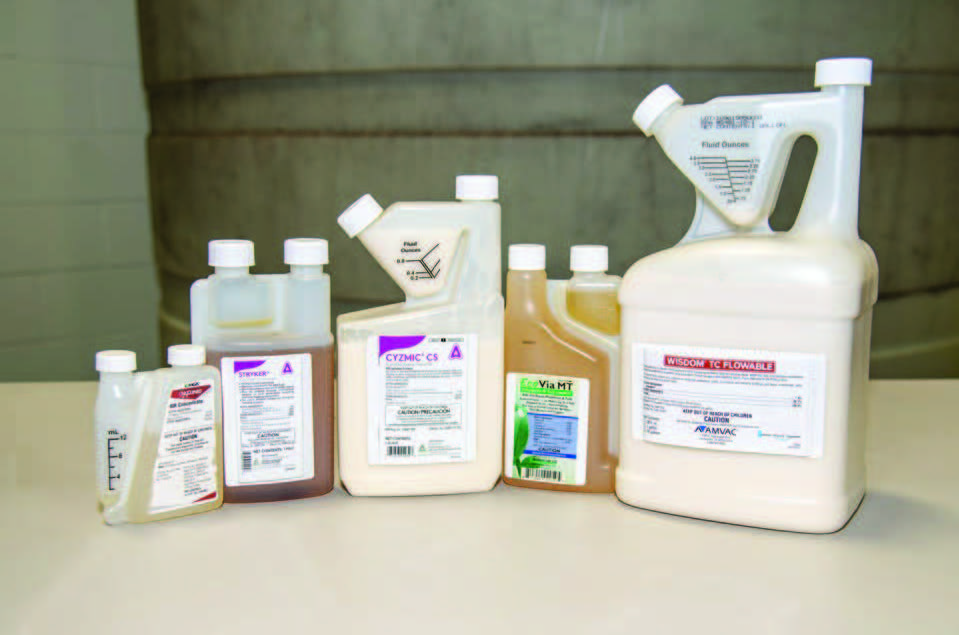 There are many insecticide products labeled for mosquito control. Most of them are packaged in “tip and pour” containers that allow for easier and more accurate mixing.
There are many insecticide products labeled for mosquito control. Most of them are packaged in “tip and pour” containers that allow for easier and more accurate mixing. 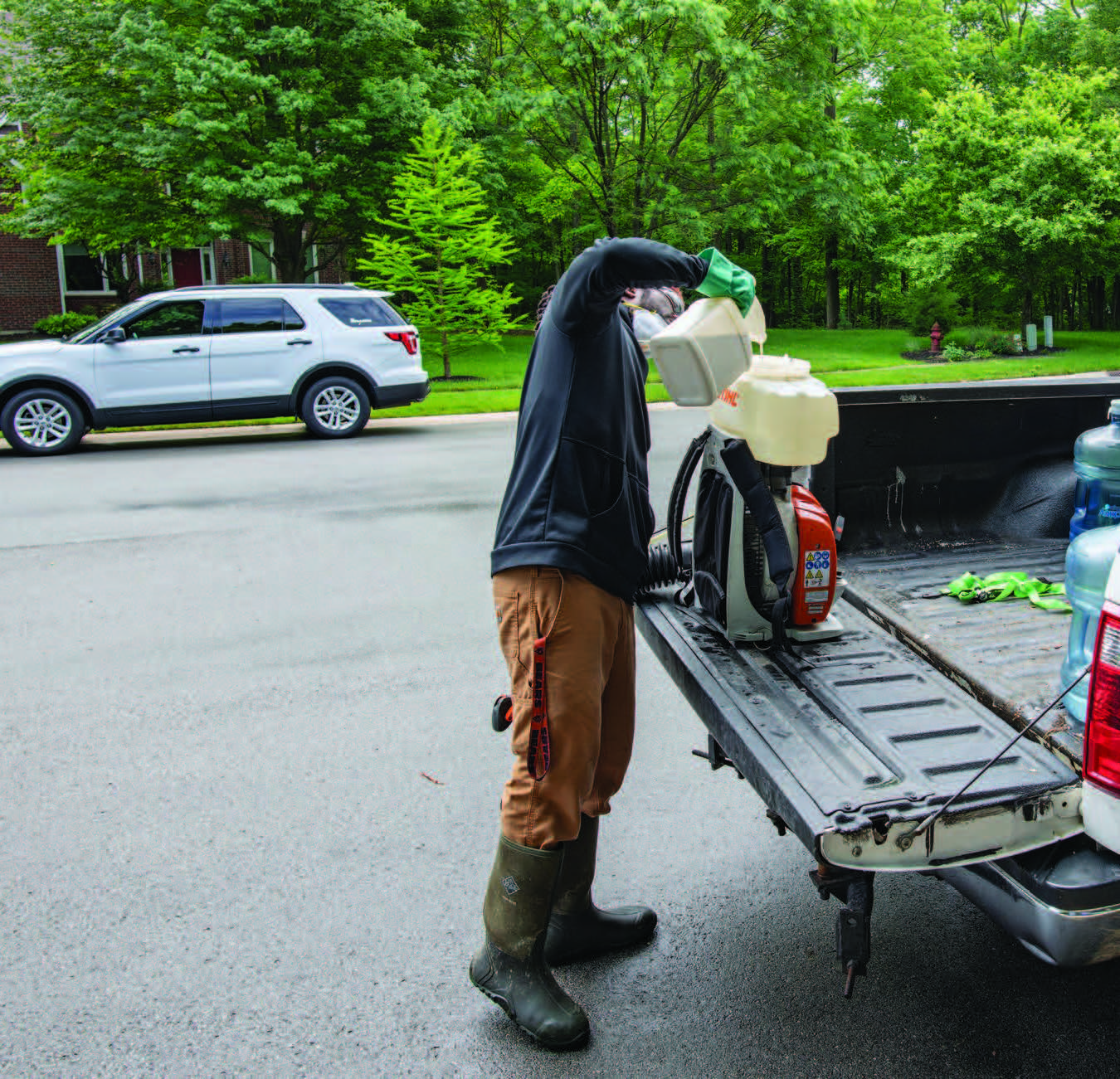 Tip-and-pour containers are popular with applicators, because they also have measurement units on the plastic. Make sure the container carrying water is
marked “nonpotable.” Some companies ask their employees to fill over pervious surfaces like a customer’s lawn. A spill in the street could enter a catch basin.
Tip-and-pour containers are popular with applicators, because they also have measurement units on the plastic. Make sure the container carrying water is
marked “nonpotable.” Some companies ask their employees to fill over pervious surfaces like a customer’s lawn. A spill in the street could enter a catch basin. 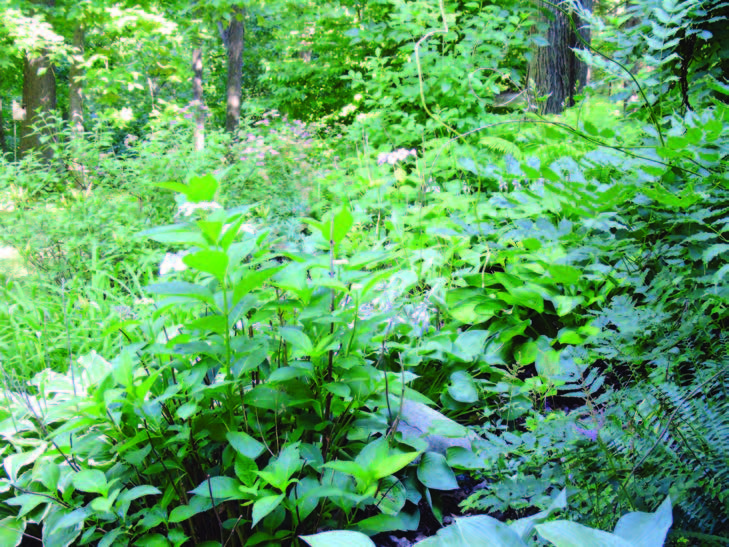 These plants provide a moist and protected habitat for resting mosquitoes.
These plants provide a moist and protected habitat for resting mosquitoes. 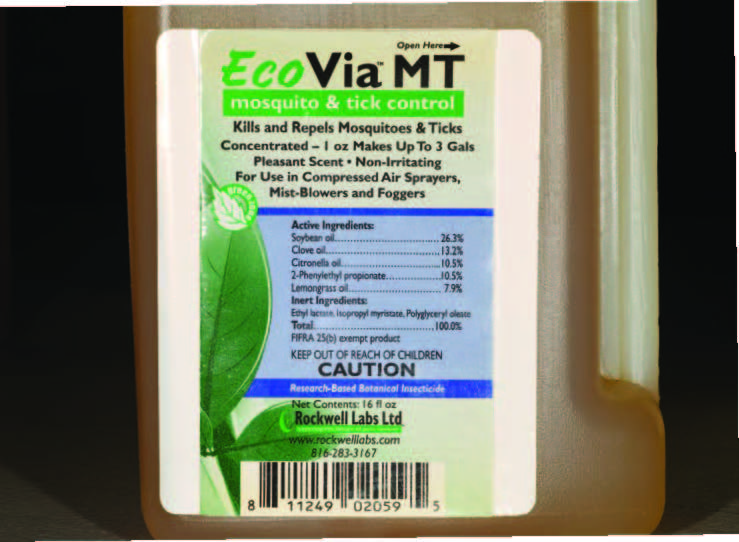 An organic mosquito control product placed in a tip and pour container.
An organic mosquito control product placed in a tip and pour container. 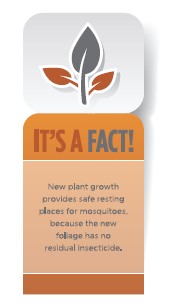
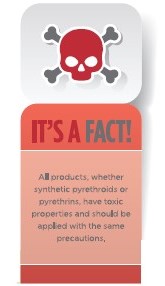
ADULT CONTROL RELIES ON BACKPACK MIST BLOWERS
Controlling adult mosquitoes in their resting sites requires forcing insecticide droplets deep into thick foliage to deposit as many small drops on the foliage as possible while keeping control of the spray. Mosquitoes that are resting at the time of the insecticide application are killed on contact with the insecticide. The repellency then sets up the second part of the treatment that keeps mosquitoes from resting on the treated foliage.
The third part of the treatment is that products need to remain active long enough to control mosquitoes between your visits. The size of droplets used in residential mosquito work is larger than the size selected for community supported applications. Community supported programs need applications that use very fine drops that can remain and float in the air so that the drops kill adult mosquitoes on contact over larger areas. This aerosol application is intended to kill flying mosquitoes and will leave little to no residue behind. On the other hand, applications on residential properties require larger drops meant for contacting mosquitoes in harborages and for leaving enough residue for extended control.
The majority of companies use backpack mist blowers in their operations. Mist blowers:
• Can quickly treat a property
• Produce ideal droplet sizes that cover and remain on leaf surfaces
• Create wind turbulence that treats both sides of leaves
• Can penetrate deep into the foliage
• Provide for worker safety by not having to work too close to the application
The fine, high-speed mist blowers produce great coverage on foliage, but also substantially increases the risk of unintended drift. It takes trained and experienced applicators to minimize drift to non-target sites both on the customer’s property and neighbors. Simply put, a mist blower consists of two parts: a pump that has an adjustable flow rate and a blower that determines the force of the air flow. Once adjusted, mist blowers provide thorough coverage of leaf surfaces while minimizing the amount of insecticide applied into the environment.
The first step in using a mist blower is to ensure you create the proper size of drops. Drops that are too large will simply roll or drop off leaf surfaces, therefore minimizing contact with and control of adult mosquitoes. The goal is to get the smallest drops possible that will remain on-site and prevent droplets moving to unwanted sites. You can see the spray droplets by looking at the mist as it leaves the mist blower. Both the flow rate set by the rate adjustment knob and the air flow is determined by the blower’s revolutions per minute. Overall, the backpack mist blower, once operated according to the manufacturer’s instructions, gets the desired coverage while also using a minimal amount of insecticide.
Applicators sometimes use other pieces of equipment, including hand-pumped or battery-operated standard backpacks. Low-pressure backpack sprayers are slow, labor-intensive, and somewhat less effective. But because they are less likely to result in drift, backpack sprayers may prove useful spot-treating along property boundaries, next to water, or at other sensitive sites.
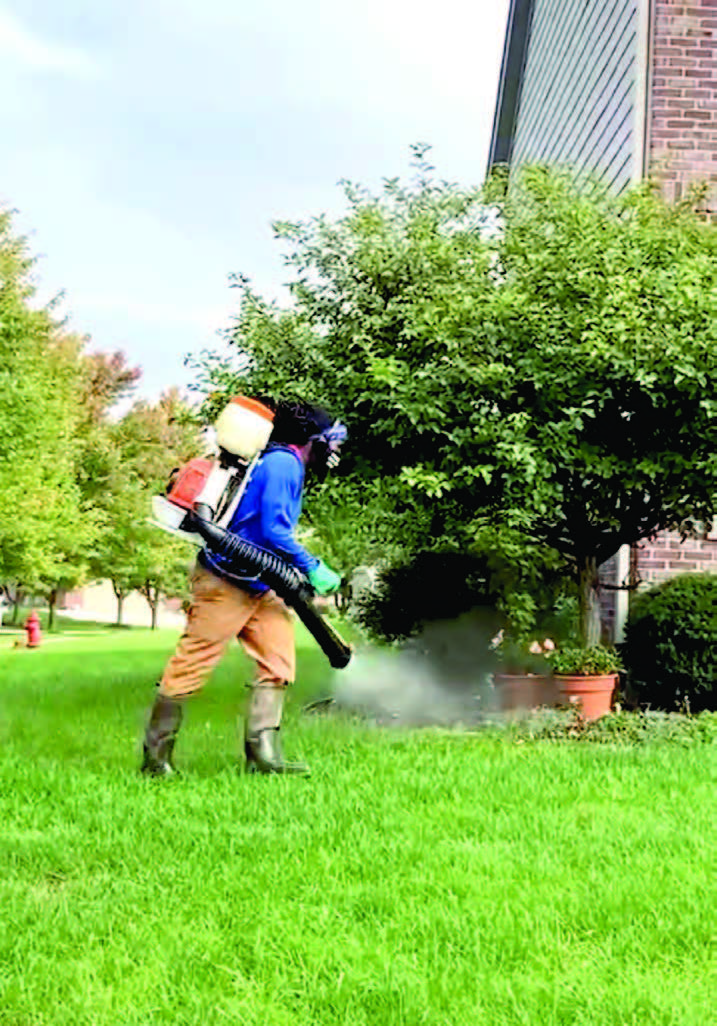 A backpack mist blower delivers small droplets pushed by air to coat both sides of the leaves.
A backpack mist blower delivers small droplets pushed by air to coat both sides of the leaves. 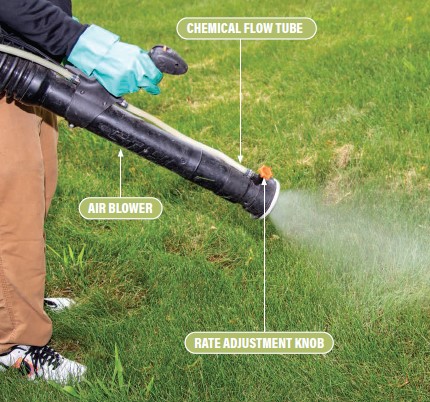
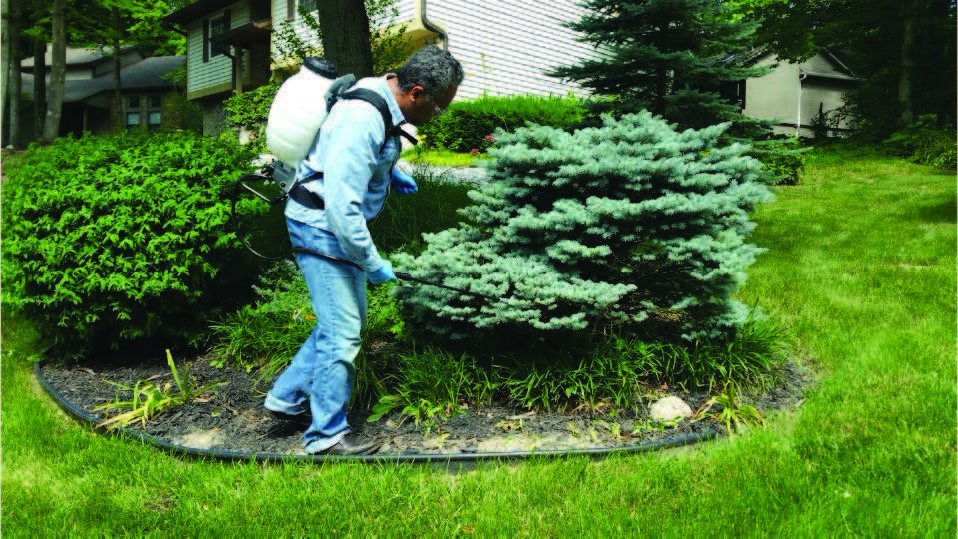 A typical backpack is not very effective for adult mosquito control, because the drops are too large to coat the leaves. A backpack might be useful to treat the boundary between two properties because the larger droplets pose less risk for off-target movement of the insecticide.
A typical backpack is not very effective for adult mosquito control, because the drops are too large to coat the leaves. A backpack might be useful to treat the boundary between two properties because the larger droplets pose less risk for off-target movement of the insecticide. 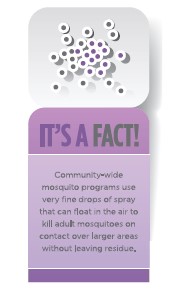
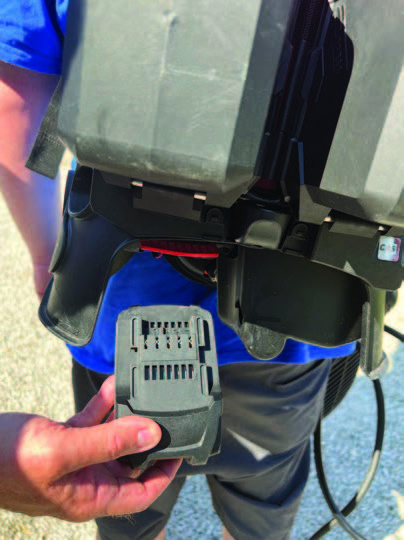
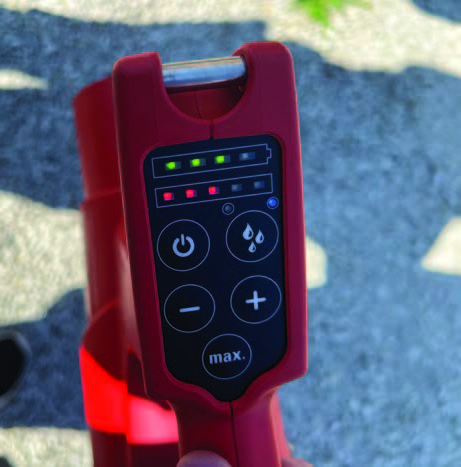
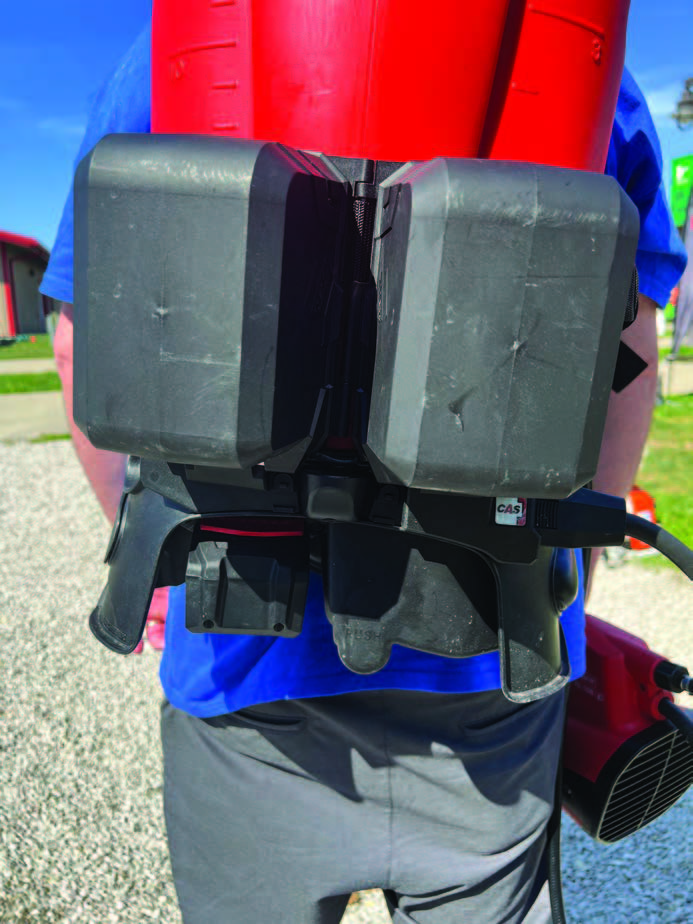 There are battery-powered backpack mist blowers available that are much quieter than their gas-powered counterparts.
There are battery-powered backpack mist blowers available that are much quieter than their gas-powered counterparts. 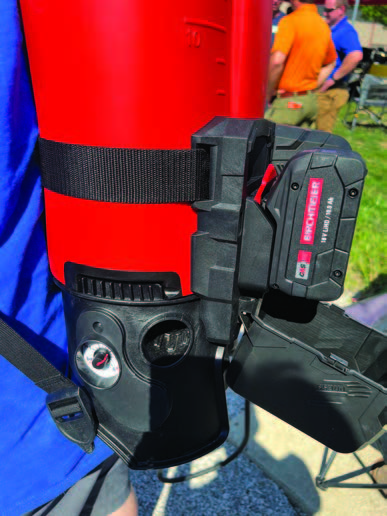
THINK SHADE WHEN APPLYING
The mosquito control season can start as early as late April and last into early November. A rule of thumb is that barrier treatments should be made starting around Memorial Day (last Monday of May) through Labor Day (first Monday in September). A more refined way of determining the first round of applications is to watch ambient temperatures. Mosquito activity becomes more noticeable when air temperatures during the day average 70°F and at night about 60°F.

If you have ever been hunting, fishing, or birdwatching, you know habitat determines where you will find these animals. The preferred resting habitat for adult mosquitoes is plants that create shady locations. Typical resting sites can include:
• Trees and shrubs
• Mulch and climbing ivy
• Ornamental plants
• Hanging plants
• Hedges along neighboring yards
• Weedy areas
• Tall grass
• Lower limbs of trees
• Beneath shady, moist decks and porches
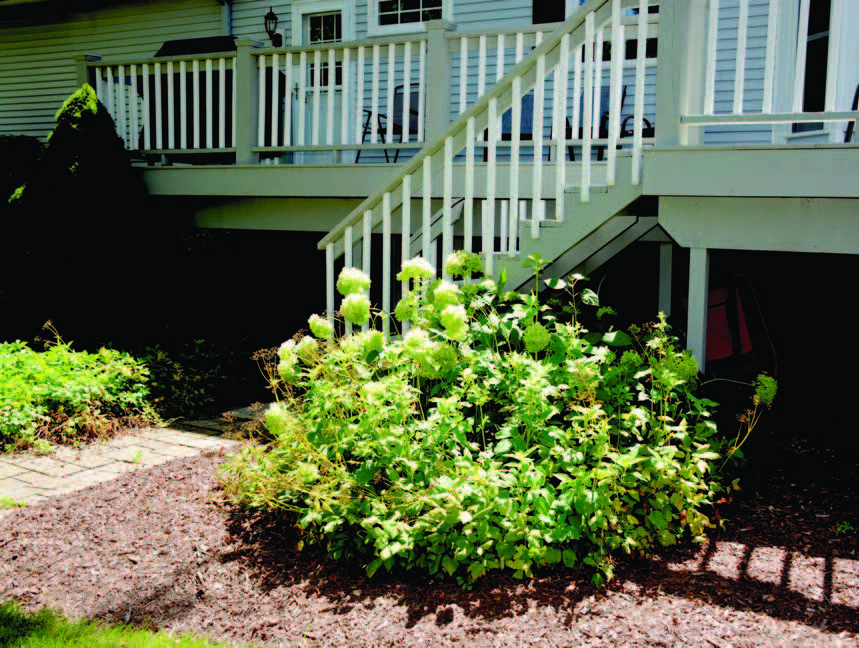
An effective mosquito control application will require treating under the deck, but at the same time the applicator must make sure not to move any insecticide onto the flowering plant.
The off-target drift potential with backpack mist blowers is a real issue that you must control. Mist blowers use high pressures to create smaller drops that increase product efficacy, but those same small drops can easily coat the outside of swings, pools, and pollinator-friendly plants. Drift can occur on the site or onto neighboring properties.
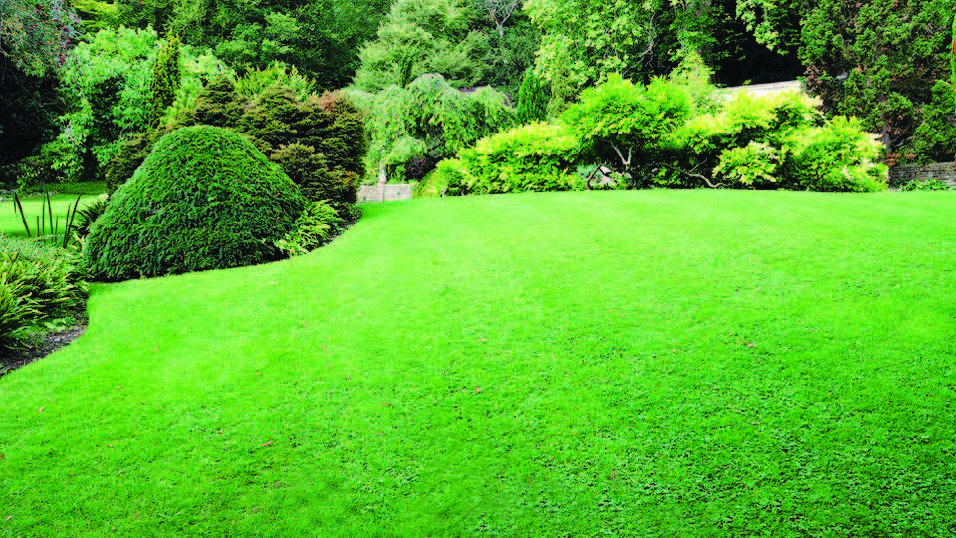
Keeping the insecticide on the customer’s property is essential to keep neighbor complaints to a minimum.
The list below provides some of the more common areas you should NOT treat or allow drift to contact when making residential mosquito control applications. These sites include items that produce food, including, gardens and fruit trees; places where people and pets play; and flowering plants that attract pollinators.
| • Blooming plants | • Playground equipment |
| • Food crops in gardens | • Beehives |
| • Fruit trees | • Children and pet toys |
| • Outdoor railings | • Pet resting areas |
| • Chairs and tables | • Outdoor kitchens |
| • Picnic tables | • Basement window wells |
| • Mowed turf | • Windows and doors |
| • Swimming pools | • Pond edges |
| • Cattails along ponds | • Screened enclosures |
| • Bird feeders | • Ornamental ponds |
| • Bird baths | • Water gardens |
Can you see the challenges of using backpack mist blowers?
This is why assessing the site each time you visit a property is so critical for directing the sprays where they can be effective and not cause non-target effects. Even if you were on a property 30 days before, conditions can change in the landscape. Plants that were not blooming at the time of the last application might now be in full bloom and full of foraging honeybees and butterflies.
Ask Customers Where Mosquitoes Are a Problem
When speaking to customers over the phone for the first time, find out where in their yards they are getting bitten. Ask the same question for regular customers complaining about mosquito bites after you have treated their properties. For instance, a customer could tell you that they are bothered with mosquitoes when they use their new outdoor kitchen. They are mad that they spent all that money on an outdoor kitchen and that the mosquitoes make it almost impossible to use.
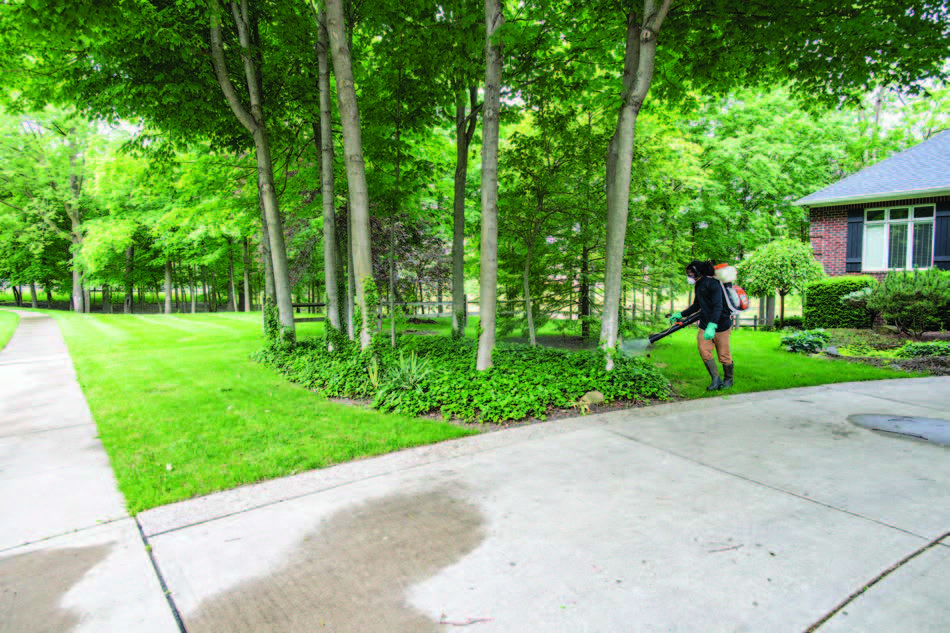
By asking a customer where in the yard they are experiencing mosquitoes, you can better target your applications.
This allows you to understand what their request is to begin with. You are trying to find out where on their property they are having difficulties so you can pinpoint a problem and come up with an effective solution. As we have seen from previous examples, the source of the problem could include standing water in a kid’s abandoned plastic pool or an old grill stuck under the porch. Getting a little information can also prevent a costly service call.
Have a Customer To-Do List
One of the easiest ways to communicate with your customers is to develop a list of things you expect them to do before you arrive. The list could direct customers to keep pets and children indoors, unlock gates, empty water sources, and put away pet food containers, small children’s toys, pet toys, and tools. Encourage them to have their gutters cleaned once a year — possibly twice if they have large overhanging trees. Make sure your list is an attractive document that will catch your customers’ attention.
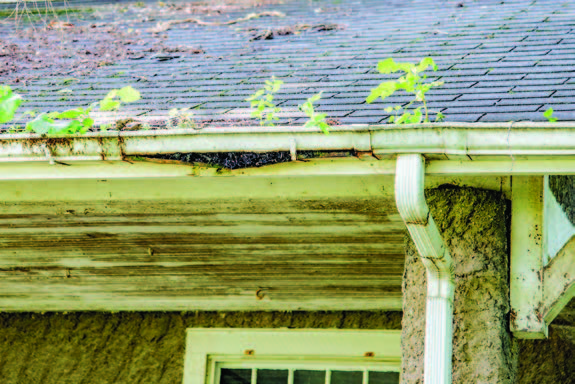 On some properties, clogged and broken gutters can create harborage for adult mosquitoes.
On some properties, clogged and broken gutters can create harborage for adult mosquitoes. 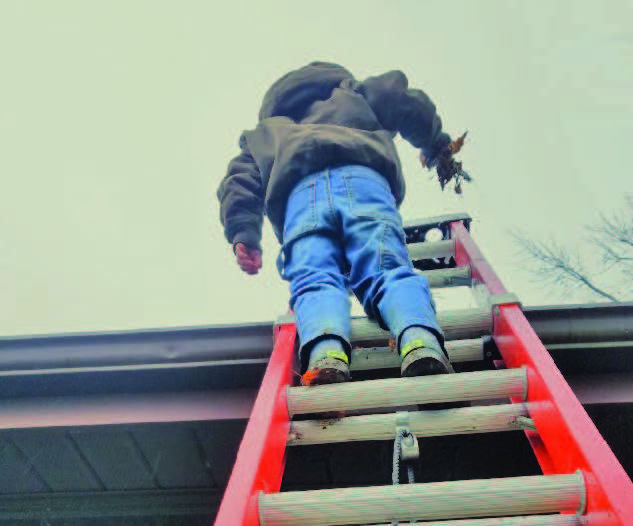
YOUR JOB IS TO KILL MOSQUITOES; MY JOB IS TO PAY YOU TO KILL THEM
You should involve customers in reducing water sources and removing or covering items as much as possible for you to make effective and safe treatments. Let them now that with their cooperation, we can achieve the desired result of fewer mosquitoes. Develop a handout that lists things customers can do to help you (and better control the mosquitoes). Tell them to pick up toys, keep pets indoors, put chairs
and any other items away or cover them if possible.
Some residents will also cover their gardens. Let customers know that mosquitoes lay eggs in standing water. That standing water could be as little as a cup in a vase on the patio. Have customers walk their property looking to eliminate as much water as possible.
Contact Customers Prior to Application Day
A step some applicators overlook is to contact customers the day before your arrival to remind them that you have a scheduled appointment and that they need to get the property ready for your application. You can resend the to-do list as a reminder.
Mix the Product Properly
There are a couple options for mixing products and filling your mist blower. One option is to fill the blower with product that was mixed in the shop and transported to the site in a larger tank — either a nurse tank or service container. A typical nurse tank for mosquito applications should have a dedicated pump and hose to prevent cross-contamination and hold about 50 gallons.
An advantage to this option is there is no mixing on the customer’s property. Disadvantages are the increased weight in the vehicle and the possibility of larger spills. If you choose a service container (if your state allows this), make sure to write down the EPA number and the name of the product. For some companies, mixing at the shop ensure that the insecticide is mixed with the right amount of water.
A second option is to mix the product on-site. In this option, you still use a nurse tank, but in this case, you only fill it with water. Use the water from the nurse tank to fill the mist blower, and then mix the product into the blower tank. The advantage of this option is that there is a smaller volume in the case of a spill. The disadvantage is that you are mixing on the street or the customer’s property.
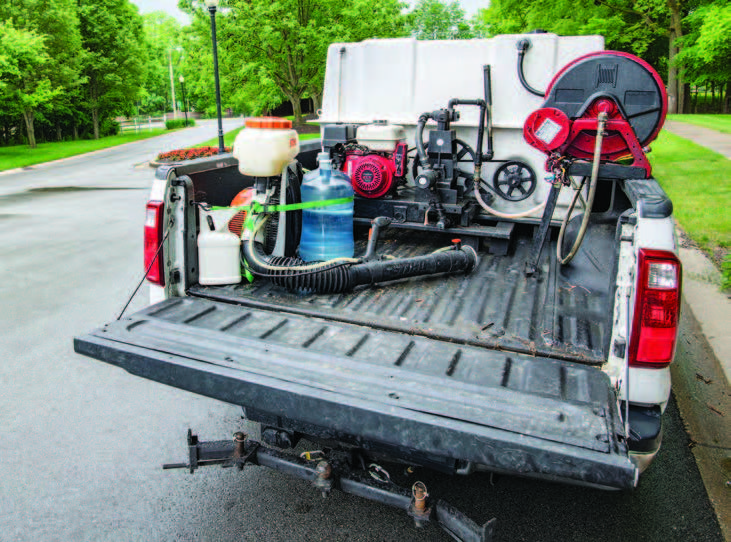 This applicator transports his own water (in a blue plastic bottle) to mix the insecticide (in a tip and pour container) into his 4-gallon backpack mist blower.
This applicator transports his own water (in a blue plastic bottle) to mix the insecticide (in a tip and pour container) into his 4-gallon backpack mist blower. 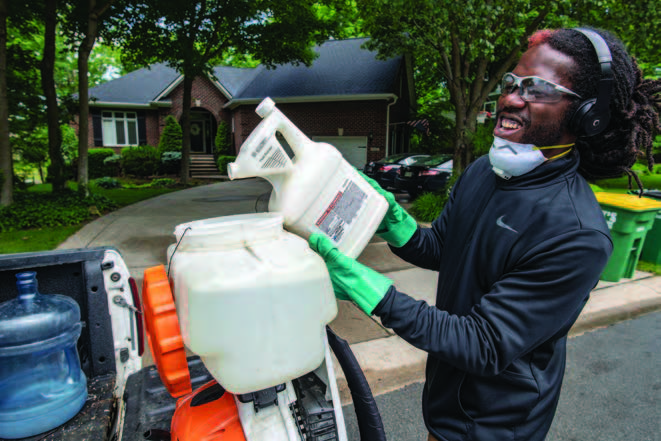
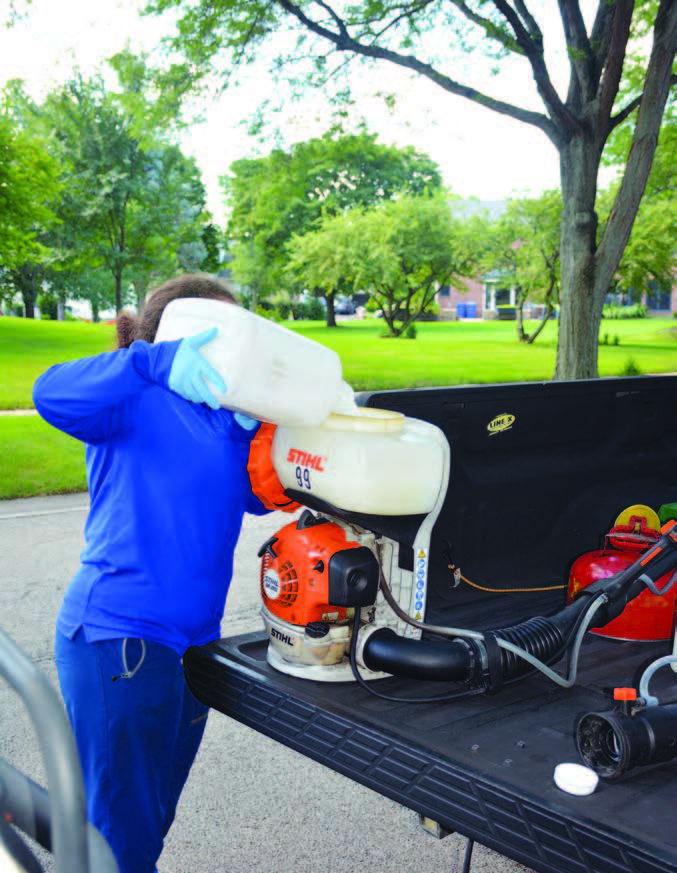
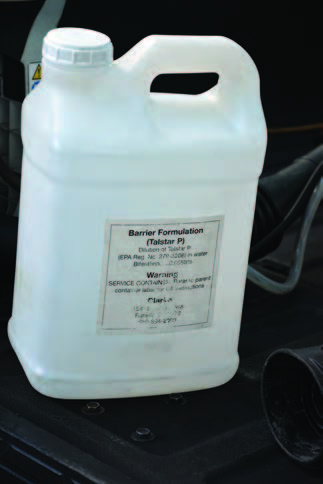 An example of a service container that is premixed at the office and taken to the field.
An example of a service container that is premixed at the office and taken to the field. Make the Application
Begin the application process by placing the sprayer on the truck’s tailgate to allow it to slip on more easily. Pay special attention to the direction the wind is blowing. Whenever possible, try to make the application so the wind carries the product away from neighboring properties. Set the blower to moderate speed as you begin. Walk at a comfortable pace, spraying behind or beside you as you move forward.
In this way you can look ahead for what is coming up. It also keeps the insecticide off you. Apply the product with a circular motion. This motion helps create turbulence that allows you to coat both sides of the leaf surface. Using a circular motion also allows you to control the direction of the spray. A circular motion toward the right (clockwise) moves the spray to the right, while a circular motion to the left moves the insecticide to the left.
Keep the spray as low as possible near the base of plants. You want the insecticide to move up into the interior of plants, so it contacts the upper and lower leaf surfaces where mosquitoes are likely to rest. You need to have the blower tube within 1 foot of what you are spraying if you expect to move the material throughout
the plant.
To demonstrate that distance from the plant is important, we used yellow, water-sensitive cards to show coverage (or the lack thereof) in the following photos. When water hits the paper, the yellow card turns blue. What can you say about the following photographs?
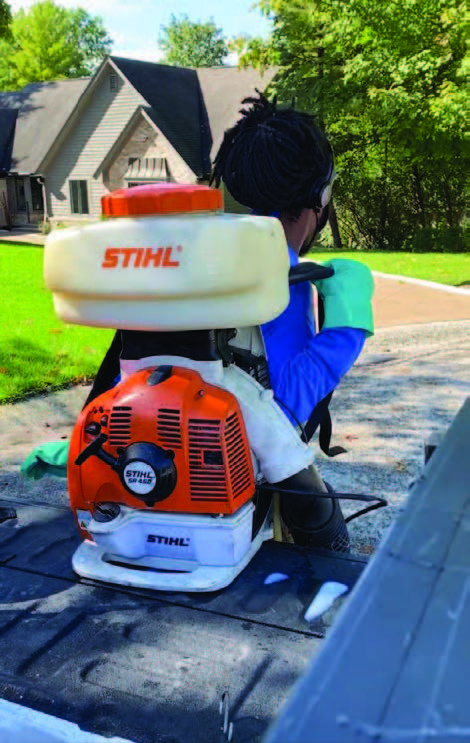 A full backpack mist blower is heavy. Instead of lifting the blower off the ground, place it on the tailgate and slip the straps over your shoulders.
A full backpack mist blower is heavy. Instead of lifting the blower off the ground, place it on the tailgate and slip the straps over your shoulders. 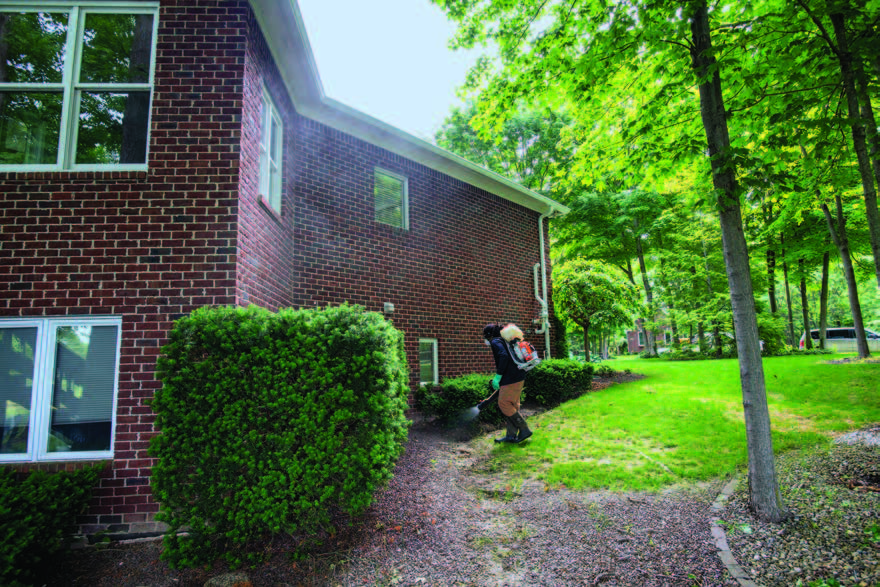 See how the spray mist is moving upward from the plant that was treated from the bottom. This ensures a good coating on both sides of most of the leaves.
See how the spray mist is moving upward from the plant that was treated from the bottom. This ensures a good coating on both sides of most of the leaves. 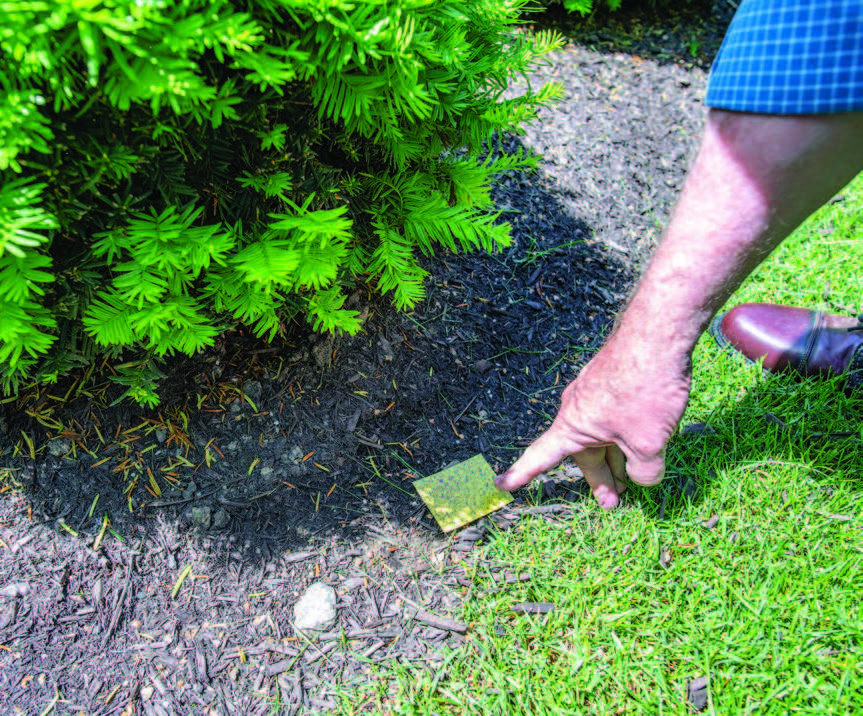 Spraying near the plant’s base shows good coverage.
Spraying near the plant’s base shows good coverage. 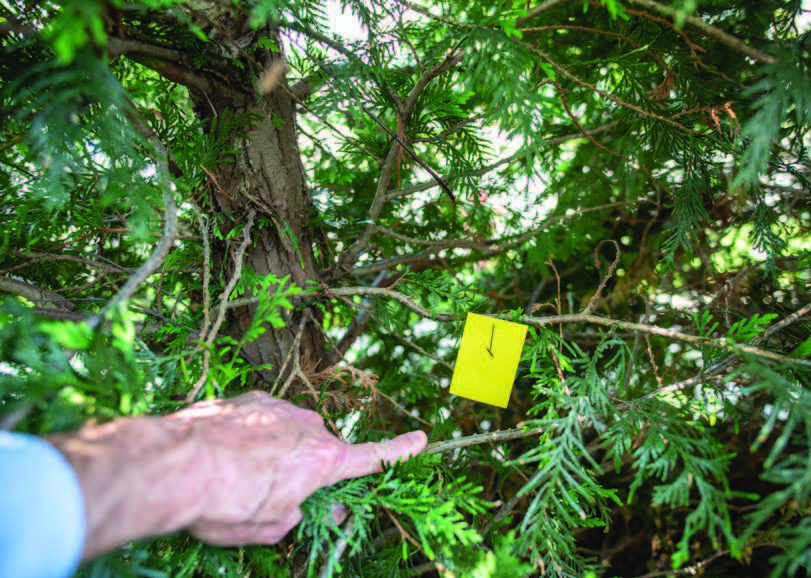 An area around a brush line shows no penetration when the application was made
too far from the base.
An area around a brush line shows no penetration when the application was made
too far from the base. 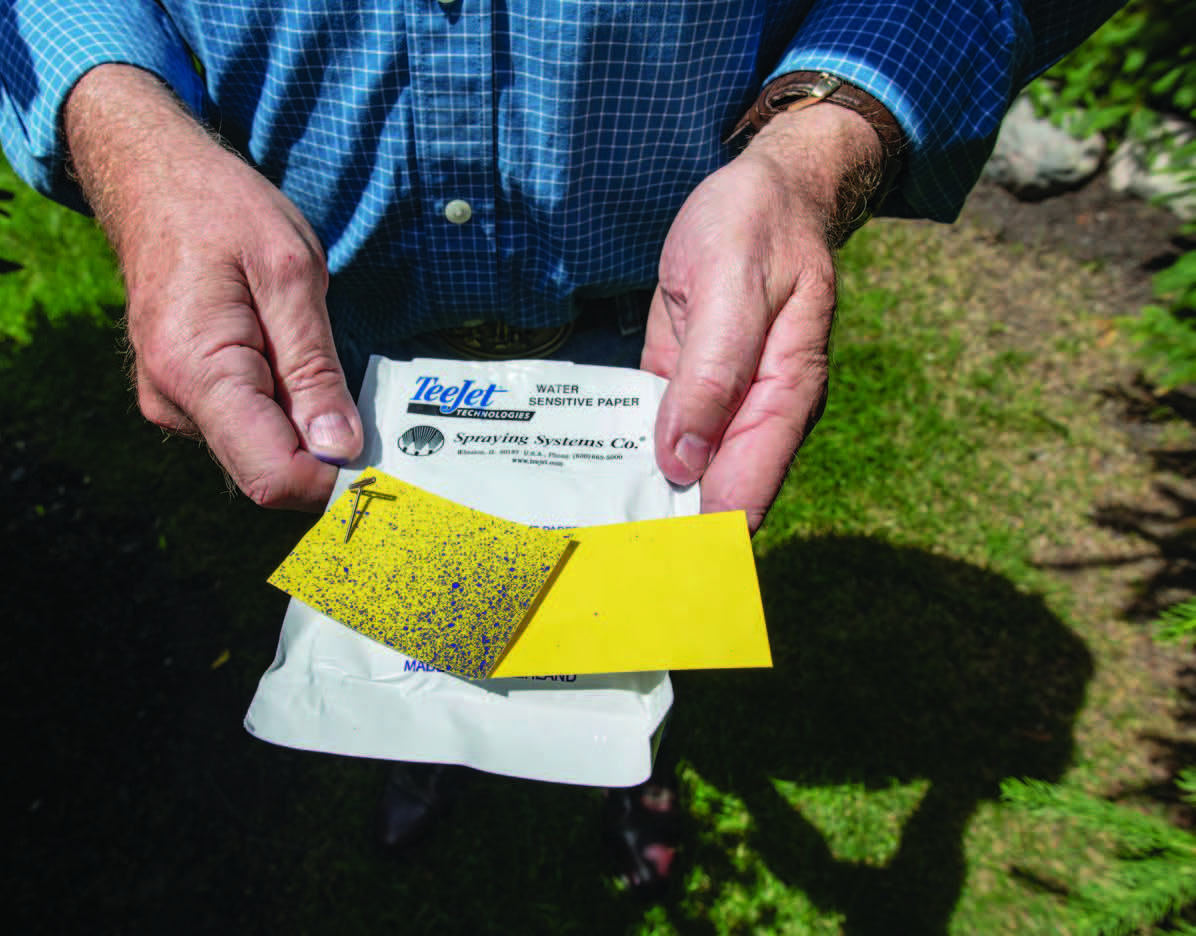 The many blue dots on the paper show good coverage from spraying near the plant’s base. The water-sensitive card inside this tree shows no insecticide spray penetrated the interior. The difference between the coverage was the distance away from what was being sprayed; the farther away, the less coverage within the plant’s interior.
The many blue dots on the paper show good coverage from spraying near the plant’s base. The water-sensitive card inside this tree shows no insecticide spray penetrated the interior. The difference between the coverage was the distance away from what was being sprayed; the farther away, the less coverage within the plant’s interior. TIPS FOR TRAINING NEW EMPLOYEES
Each manufacturer builds its backpack blower differently. There are slight variations in how to operate them and how they work. Knowing your equipment and how it affects your application technique are critical. Properly using a backpack mist blower is both a science and art. Using water-sensitive cards can help new applicators better understand what they are trying to accomplish. Water-sensitive cards are made of special yellow paper that changes to blue whenever water drops hit them.
Place the cards inside bushes at different depths in the plants. Make the application with the throttle in the middle setting with only water, and then check the cards to see if there are lots of blue spots on them. The cards will tell you if the sprays are penetrating into the deeper parts of the vegetation. If there is not enough penetration, adjust the blower to move the material into the interior of the plant. You can also set the water-sensitive cards at different distances to allow the applicator to see how far the water droplets move off target. These results will help teach applicators how to use the nozzle to direct treatments away from neighbors’ properties, and how to use the throttle to their advantage.
The water-sensitive cards can also simulate the application rate. Fill the mist blower with one gallon of water. Have the person spray it out and then measure how much area was sprayed, since most labels state how much material it takes cover 1,000 square feet or 1,000 cubic feet.
Protect What Is on the Other Side of the Fence
You may be able to effectively treat a shade tree on a customer’s property that is hundreds of feet from a property line while avoiding drift onto a neighbor’s property, but that is not always the case. Many residential lots are small enough that treating anything above head-high would certainly result in off-target drift. In these situations, it is a good habit to keep your wrist below your elbow while making applications. This arm position naturally directs the spray downward and minimizes the product drifting to non-target sites both on the customer’s property and neighbor’s.
A neighbor bordering your customer’s property may not want insecticide on their side of the property line. In fact, they may even have confronted you about previous applications. Most of the time, you will not know that until you have inadvertently drifted the insecticide onto their property. You should assume that all properties adjacent to your customers are “no-spray zones,” which means you should always direct applications along property lines away from neighboring properties.
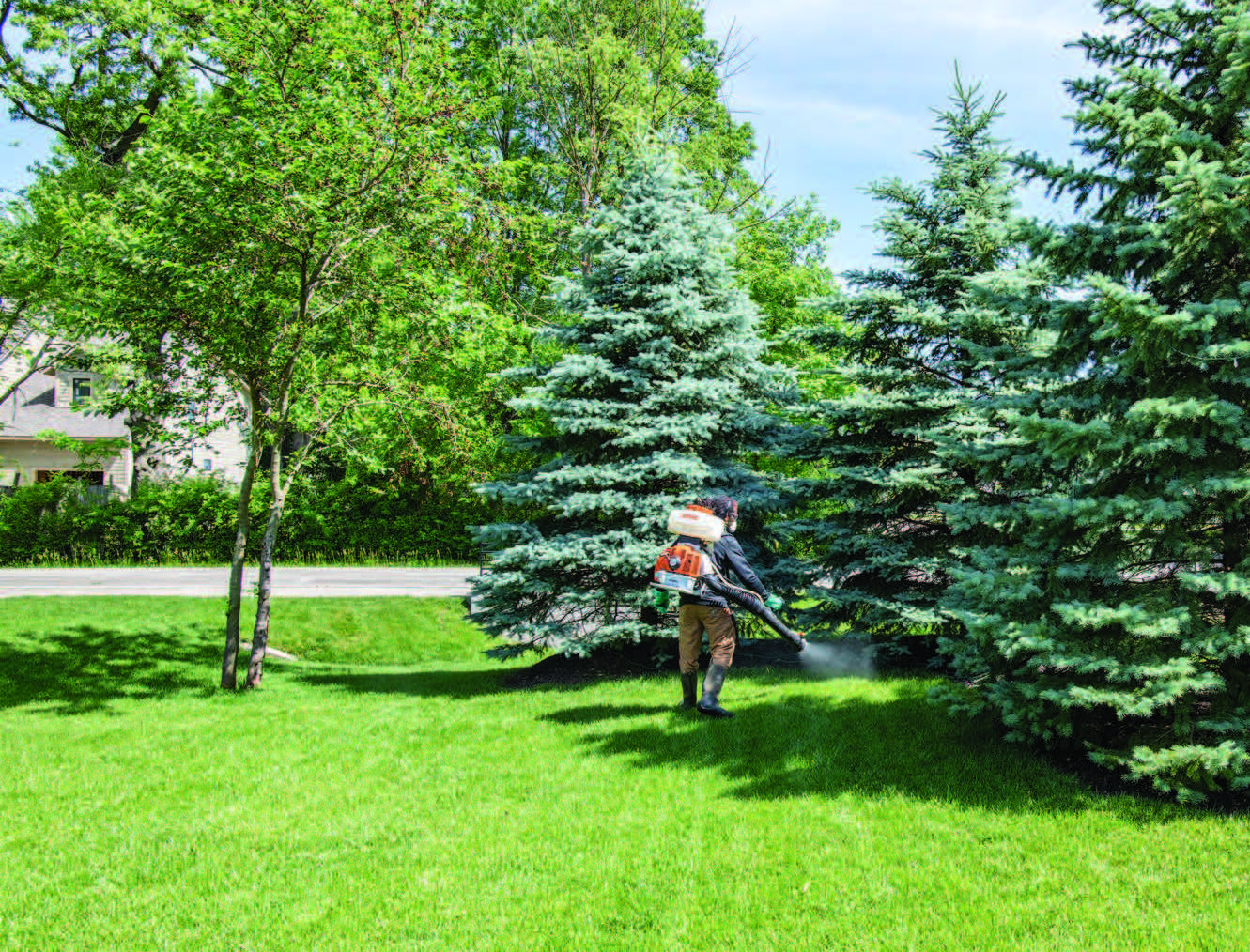
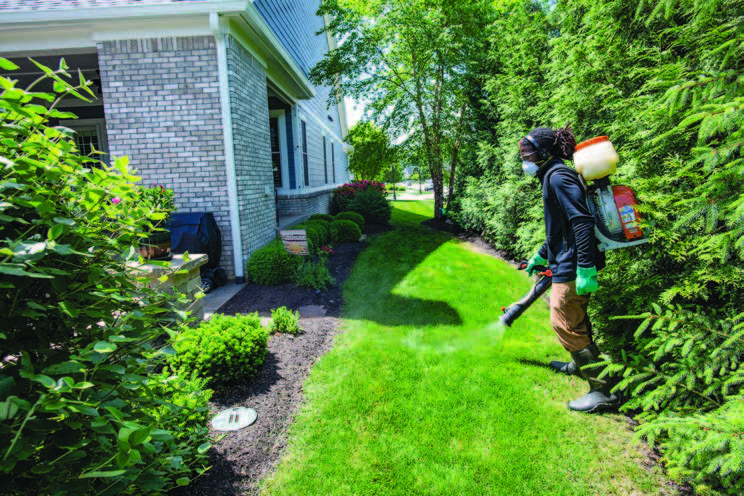 A demonstration with water-sensitive paper shows that the farther away a blower tube is from a harborage site, the less penetration will occur within the plant.
A demonstration with water-sensitive paper shows that the farther away a blower tube is from a harborage site, the less penetration will occur within the plant. 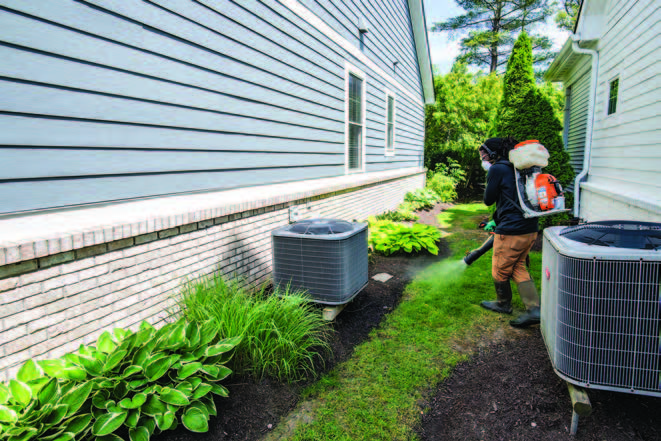 Keep the sprayer mist blowing toward the customer’s property when you are treating in tight places - like this example between houses separated by only a few feet.
Keep the sprayer mist blowing toward the customer’s property when you are treating in tight places - like this example between houses separated by only a few feet. 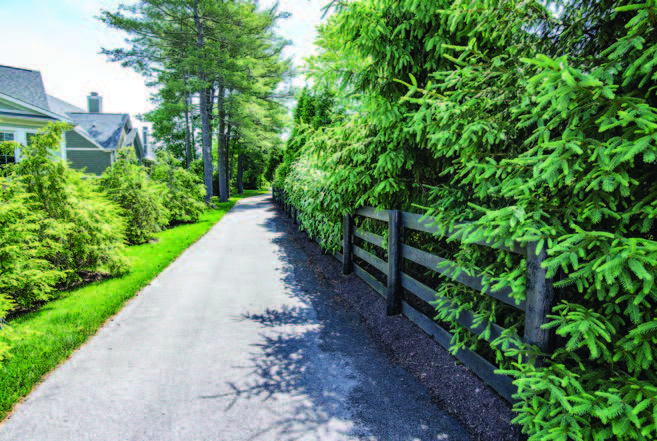 The applicator at his customer’s property (left of fence) borders a common walkway through the community
The applicator at his customer’s property (left of fence) borders a common walkway through the community 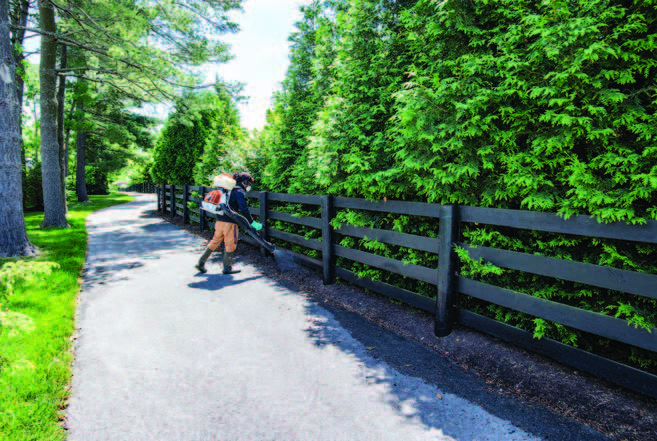 By starting when there is no one using the walkway, the applicator can direct his sprays into the tree line without concern about exposure
By starting when there is no one using the walkway, the applicator can direct his sprays into the tree line without concern about exposure 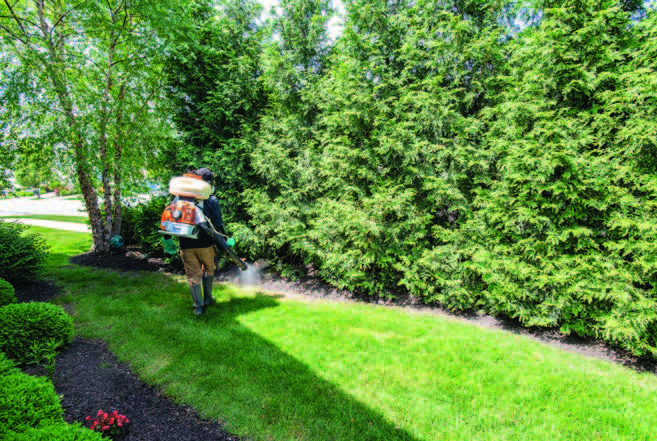 Within the property, the applicator can now effectively treat into the tree line.
Within the property, the applicator can now effectively treat into the tree line. Avoiding applications high into the air is one way to avoid excess drift, but what about making applications to bushes and other harborage areas that are directly adjacent to the property line? There are several options to help you avoid drift in these situations, too.
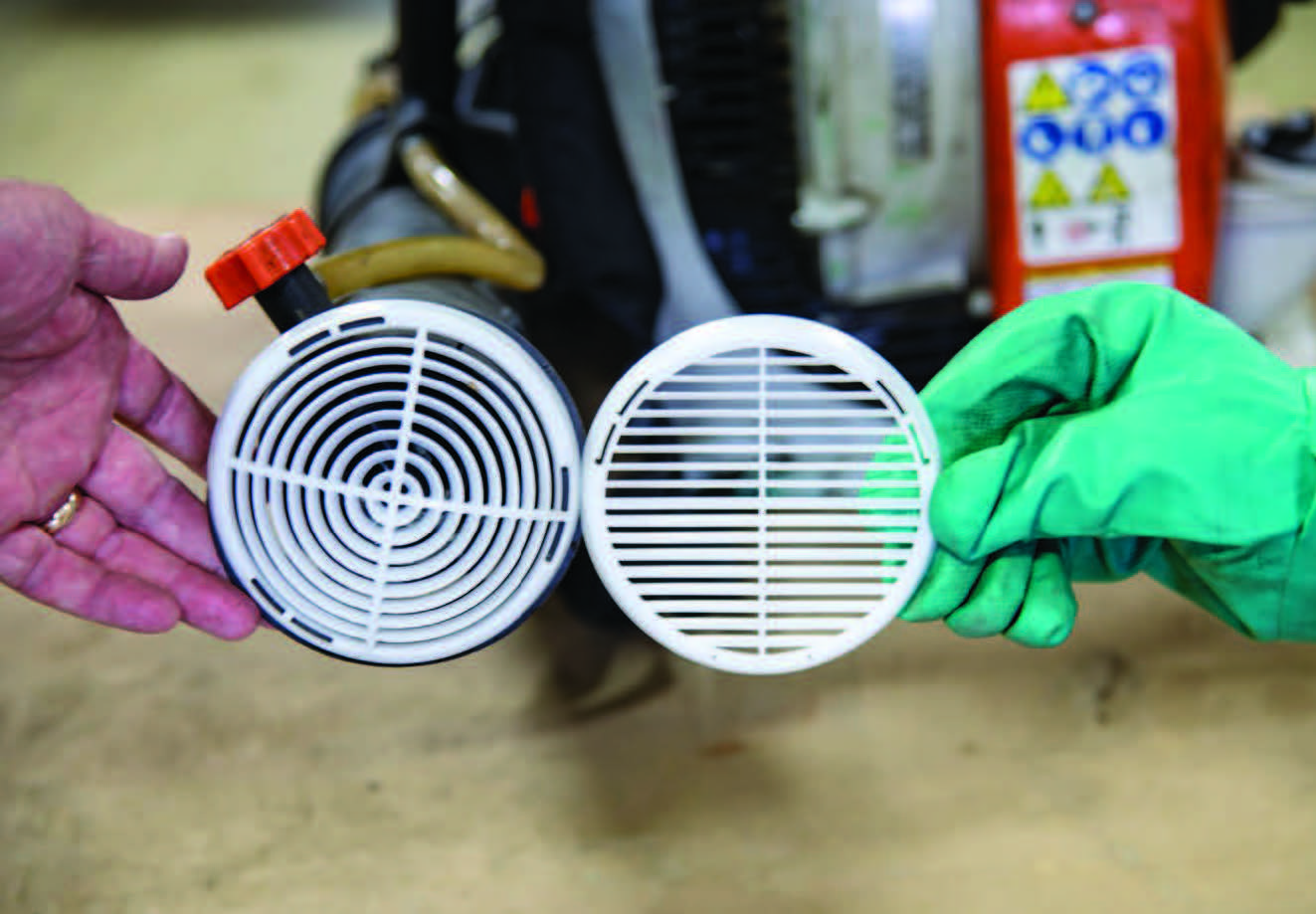
Applicators can use two types of directional nozzles. The one on the left is the more typical nozzle that blows straight out. Applicators can control the direction the spray travels by the direction of their circular application motion. The nozzle on the right has a plastic outlet cover that points down, which can keep the spray aimed downward.
First, point the sprayer nozzle in the direction of your customer’s property instead of the neighbor’s. That will allow any stray droplets to settle onto the customer’s property instead of the neighboring property. This technique requires you to walk directly down the property line, which will undoubtedly slow you down, but the extra time you spend keeping the application onsite might save you from having to deal with Office of Indiana State Chemist investigators when the neighbor files a drift complaint against you.
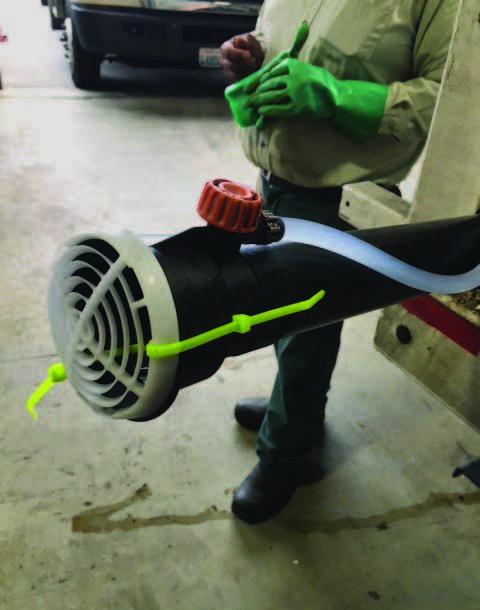
An example of securing a nozzle onto a backpack mist blower.
Another technique to avoid drift is to use a directional nozzle while walking parallel to the property line. This will direct the application either parallel with the property line or back into your customer’s property.
Manufacturers also sell devices that fit on the ends of blowers that allow you to control the direction of applications, which would be away from theneighbor’s property. Finally, a low-pressure hand sprayer may reduce the efficacy of your application, but using one will allow you to make precise applications along the property line while avoiding drift.
Treat the Customer’s Property Like Your Own
If you spray an object such as a car, swing set, or picnic table unintentionally, then rinse it off with clean water. It shows a good faith effort to take care of your customer’s property.
Keep Detailed Customer Notes
Keeping detailed customer notes can remind you of important details about a property. You can also list to-do items. Some customers may request you call ahead so they can move pets inside and unlock gates. Other customers may want you to give special attention to certain areas or may want other areas to receive no application.
It is also important to note when a neighbor is less-than-pleased with your mosquito treatments. Write down the person’s name if you have it. In some cases, you can make special arrangements, calling them ahead of the application, so they can cover their pools or bring in their pets. Failing to keep your promises will only lead to strained relationships between you and the neighbors.
You may think these customer notes are a waste of time because you have a great memory. But will you always be the applicator treating this property? What happens if you are ill or change routes? This helps keep all treatments consistent no matter who performs the job.
A CHECKLIST FOR SUCCESSFUL MOSQUITO CONTROL
• Make sure you are at the right address
• Use products that can be used with a backpack mist blower
• Adhere to product label instructions
• Identify no-touch surfaces, flowering plants, and water sources
• Pick up children and pet toys before starting
• Monitor wind direction and speed as you proceed
• Fill tank partially with water before adding insecticide and then shake the backpack blower
• Wear appropriate safety equipment, including hearing protection
• Concentrate applications in shady areas
• Walk at moderate speed
• Keep your wrist below your elbow during applications
• Apply with a circular motion to right (clockwise) to move spray right
• Apply with a circular motion to left (counterclockwise) to move spray left
• Place the blower tube 1 foot from the base of plants
• Do not spray above shoulder height
• Focus on what is coming up
• Squeeze the trigger lightly when working around non-flowering annuals and bulbs that can be damaged by the blower
• Do not spray in standing water
THE PESTICIDE LABEL: A LIST OF DO’S AND DON’T’S
All pesticide labels registered with the United States Environmental Protection Agency carry this statement: “It is a violation of federal law to use this product in a manner inconsistent with its labeling.” In other words: the label is the law. Label directions are legal requirements that all users must follow. Failing to follow label directions can subject the applicator and business to fines, penalties, lawsuits, and other actions against the applicator and/or the business.
This is why many argue that reading, understanding, and following label directions is the most important part of the application process. Product instructions can vary from one product to the next. While there are similar instructions between products, there are also significant differences. What is legal for one product might be illegal with another.
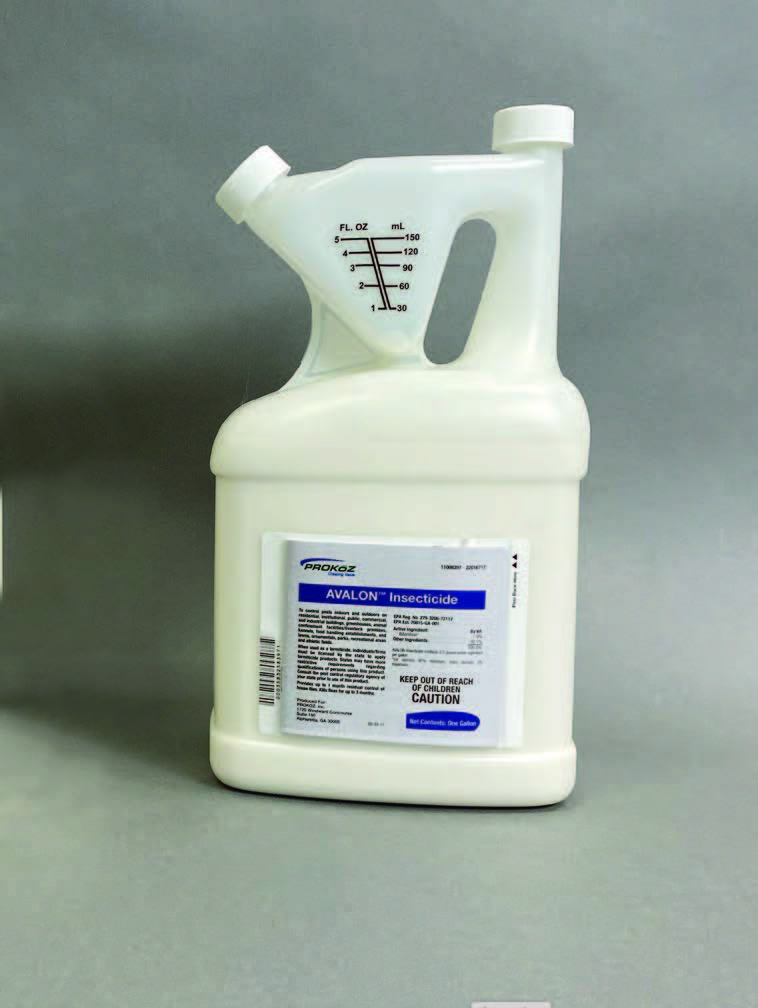
Always read product labels to see what protective equipment the applicators are required to wear.
Here is a list of common questions about adult mosquito control products and some examples of label-related statements.
Do I have to wear personal protective equipment?
Many labels require no safety equipment, while others can list one or more of the following: chemical-resistant gloves, waterproof gloves, shoes, socks, long pants, long-sleeve shirts, and respirators.

Can I spray standing water in gutters?
Generally, no. Most labels prohibit product applications to gutters.
Here is what one label states:
- “To protect the environment, do not allow pesticide to enter or run off into storm drains, drainage ditches, gutters, or surface waters.”
Do I have to worry about rainfall?
Yes. We are trying to form a barrier, and the pesticide product must dry on the surface of the foliage to form that barrier.
As some labels state:
- “Applying the product in calm weather when rain is not predicted for the next 24 hours will help to ensure that wind or rain does not blow or wash pesticides off the treated area.”
- “Do not apply in the rain.”
Can I spray under eaves or directly on buildings?
The answer depends on the label. Here is what some labels say:
- “Applications [may be made] to underside of eaves, soffits, doors, or windows permanently protected from rainfall by a covering, overhang, awning, or other structure.” Permanently protected is significant in this example.
- “Applications [may be made] to the side of a building, up to a maximum height of 3 feet above grade.” The 3 feet is significant in that you could not treat any areas higher than this.
- “Apply directly to walls, ceilings, window screens, and other resting areas as a residual surface treatment.” Treatments allowed without any restrictions.

Product labels differ in what areas you are allowed to treat for mosquitoes. Always consult the label for specific instructions.
Are the rates similar?
No, is the short answer. Rates can range from 0.25 to 5.00 fluid ounces per gallon of water to be applied per thousand square feet or thousand cubic feet.
Can I spray all plants harboring adult mosquitoes?
Synthetic products used in mosquito control are toxic to honeybees, and by default, to other insect pollinators and predators. This is why you should never treat flowers in bloom. Here are what some labels say:
- “This pesticide is highly toxic to bees exposed to direct treatment or to residues remaining on the treated area. Do not apply this product or allow to drift when bees are actively visiting the treatment area. Applications should be timed to provide the maximum possible interval between treatment and the next period of bee activity.”
- “Time application to flowering plants during periods when pollinating insects are not present, such as early morning or late evening.”
- “This product is toxic to honeybees exposed to direct application. However, dried residues of this product are non-toxic to honeybees. Treat during non-foraging periods to minimize adverse effects.”

Never spray plants in bloom because they may be attractive to pollinators. You may treat those same plants when they are no longer blooming.
Is there a limit to the number of treatments I can make?
For mosquito work where you follow a 21- to 28-day schedule, yes. Within the label allowance, the applicator selects what works the best. But some labels have additional restrictions on the interval or number of applications that can be made. Here is what some labels say:
- “Do not apply more than once per four weeks.”
- “Treatments may be applied at 21-day intervals or as necessary to maintain adequate control.”
- “Spray interval is typically 14-28 days but not more than 4 applications per month. Do not exceed 24 applications per year.”
Are there wind restrictions?
It’s probably a 50-50 chance that the label will have wind restrictions that might prevent the application from taking place. Here’s what some labels say:
- “Do not apply when wind speed exceeds 10 MPH.”
- “Do not make outdoor broadcast applications to turf and ornamentals when wind speed is 15 mph or greater.”
- “Do not apply when weather conditions favor drift from the target area.” This one is interesting. If you drift onto a neighbor’s yard, then by default, the wind speed was too high.
Can I apply to concrete and other impervious surfaces?
Applying a pesticide to concrete and other impervious surfaces is not advised because mosquitoes do not do well on concrete or asphalt. Here’s what one label says:
- “Do not apply directly to impervious horizontal surfaces such as sidewalks, driveways, and patios except as a spot or crack and crevice treatment.” If prohibited, you might use a backpack to apply around the perimeter.
Can I treat the top of the deck?
This also depends on the product label. Here’s what one label says:
- “Treat with spray…. under decks.”
Should I be concerned about pets?
Absolutely yes! Pets are like family members. Here’s what one label says:
- “When making applications, care should be used to avoid household pets.”
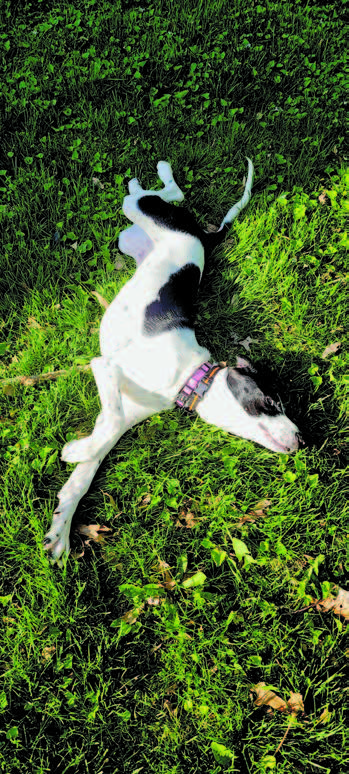
When can I tell the residents to walk back into the yard?
Most labels say until the sprays have dried. Here’s what one label says:
- “Keep children and pets off treated areas until spray has dried following application.”
Can I spray directly or indirectly into water?
No, because the insecticide could kill fish. Here’s what some labels say:
- “This product is highly toxic to fish. Do not apply directly to water.”
- “This is product is extremely toxic to fish and aquatic invertebrates. To protect the environment, do not allow pesticide to enter or run off into storm drains, drainage ditches, gutters, or surface water.”
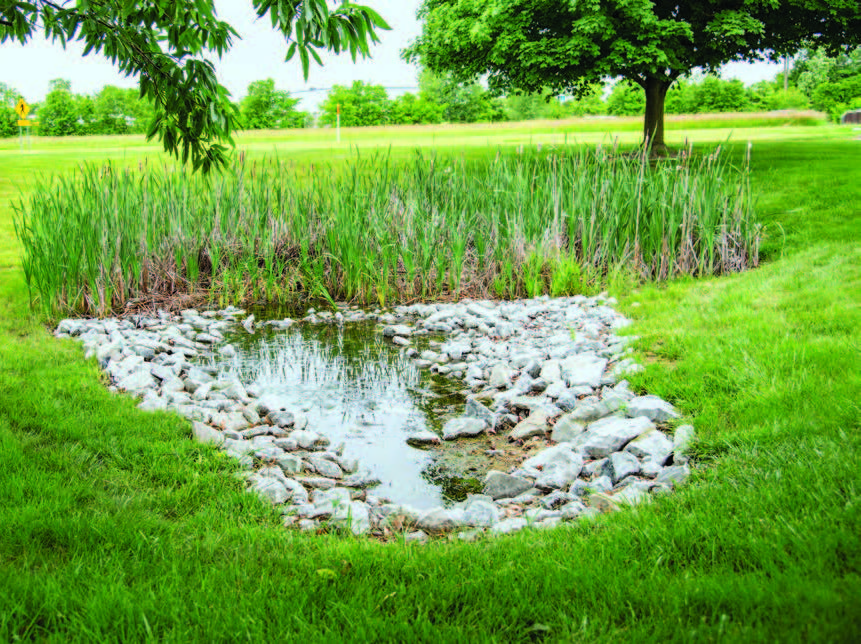
Most product labels prohibit applying insecticides for adult control into water. This specific site would be a good example where insecticides labeled for mosquito larval control would be ideal.
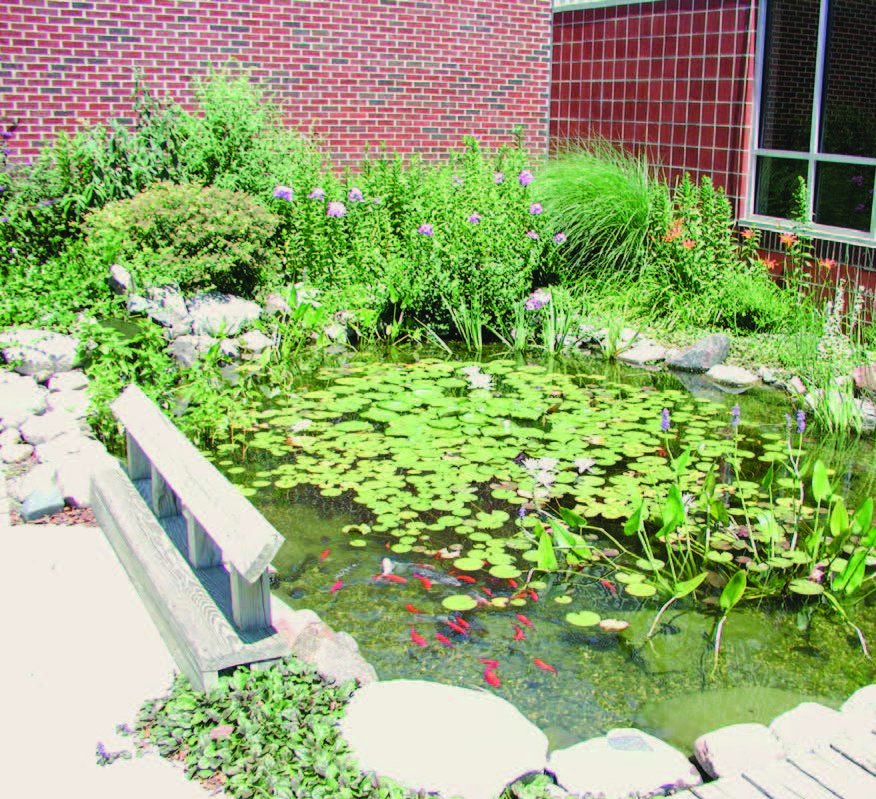
Be sure that the insecticide application will not get blown into this water holding fish.
The purpose of sharing these label examples is to show you how much labels vary among products. Based on label instructions, one activity can be legal with one product, while the same activity might be illegal with another. You can find the answers to many of the questions you have about the safe and legal use of a product on the label. If after consulting the label you are still unsure about the correct answer, work with your product supplier, your department of agriculture, or university extension.

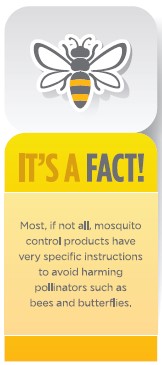
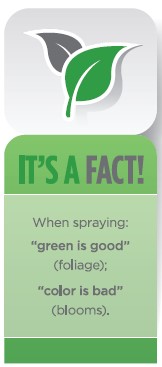
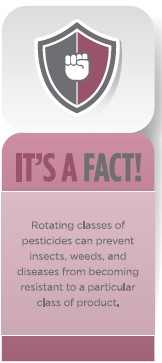
RESISTANCE MANAGEMENT
You should always rotate the pesticide grouping (known as the insecticide class) to help reduce the possibility of insects, weeds, and diseases building up a tolerance or resistance to a given product class. The more you use the same class of pesticide on a property, the less effective it may become in controlling mosquitoes. The problem is that the products used to control adult mosquitoes are mostly synthetic pyrethroids, which are classified as Group 3 insecticides. This means all the products in this class kill mosquitoes through a similar mode of action.
There is the possibility that some of the mosquitoes can survive the application and that their off spring too might not be killed by the product. Since mosquitoes reproduce in large numbers, it may not take long for the product, and any other in Group 3, to no longer be effective. The best option is to switch to another group whenever they are available. If not, there are a few other things to consider that may reduce the likelihood of mosquitoes becoming resistant to the pyrethroid insecticides.
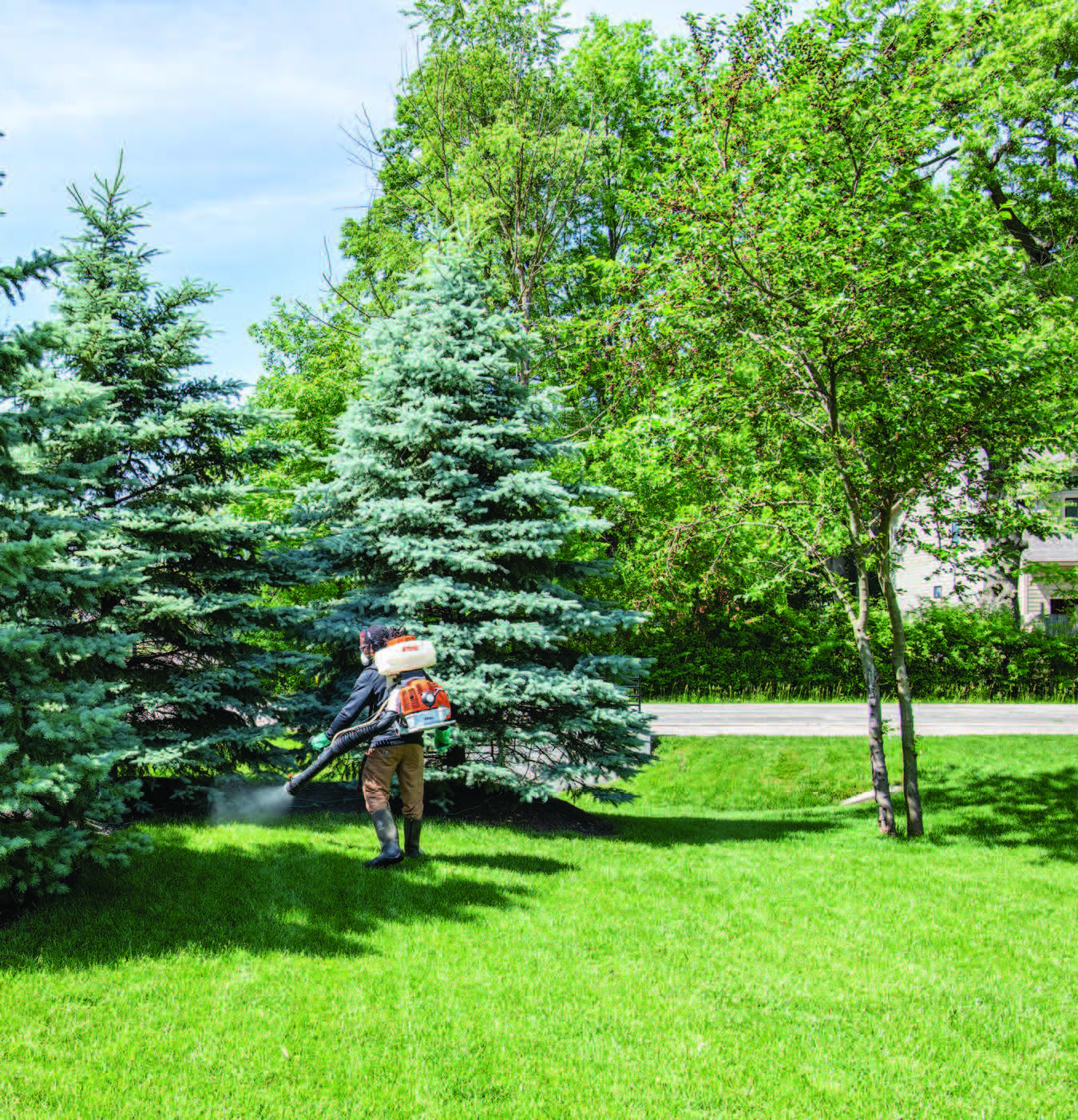
These things include:
• Use the labeled rate
• Do not apply to areas where mosquitoes are not harboring
• Apply a recommended product with a different mode of action, such as a botanical
• Avoid overapplication
• Consider lengthening the intervals between treatment
• Only make applications where evidence of adult biting mosquitoes is present
CONCLUSIONS
When the weather is right, people want to use their outdoor properties to gather with family and friends, to allow children to play, to barbecue, or to sit out in the evening for star gazing or watching the July 4th fireworks. Nobody wants to be bothered by mosquitoes buzzing around their faces, to slap mosquitoes away, or suffer from itchy bites.
This means that there are customers who are willing to hire professional companies to reduce the nuisance of biting mosquitoes. The problem professional applicators face is that mosquitoes reproduce rapidly and can have dozens of generations between their time of emergence in May to the first killing freeze in the fall. The continued reproduction and emergence of adults means suppression is a difficult and ongoing process over the course of the mosquito season.
Beyond multiple generations, there are other challenges to controlling mosquitoes, including hidden breeding locations, mosquitoes that can travel from other properties, treatments that can harm non-targets, and sprays that can potentially drift off-target. there are a lot of things that make commercial mosquito control very challenging.
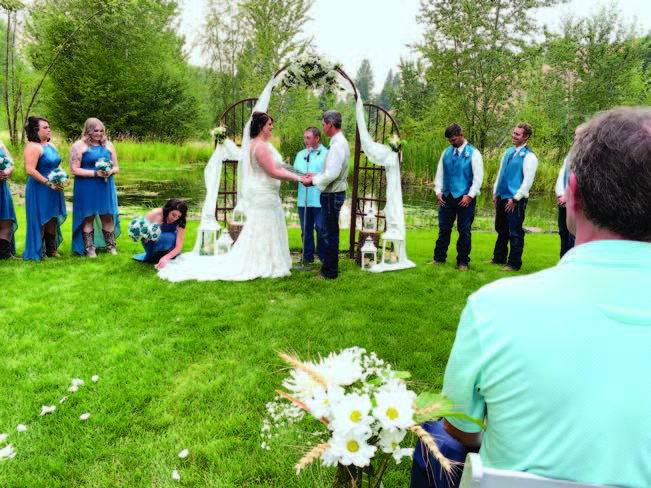
The last thing this couple would like to remember on this special occasion is their guests being bitten by mosquitoes.
It is a mistake to think that adult mosquito control is nothing more than purchasing an $800 backpack mist blower and blasting the customer’s property with an insecticide. This publication began by stressing mosquito biology as the foundation for any mosquito control program. Even the most expensive equipment and best insecticides will fail to control mosquitoes if you do not factor in how and where mosquitoes reproduce and harbor.

We often focus on controlling mosquitoes to protect people from bites; however, we can help dogs, cats, and other pets, too.
The insecticides labeled to control adult mosquitoes are well tested, but success depends on when, where, and how well the products are applied, which is linked to following directions on the product label. There can be significant issues when applying a fine mist to “postage stamp” properties. Knowing the label’s do’s and don’t’s, and your skill as an applicator are what allow you to effectively control mosquitoes on your customer’s property without generating complaints.
There are customers who prefer to use their outdoor spaces to the fullest extent possible, without the annoyance of biting mosquitoes. There are also neighbors living next to these customers who want nothing to do with your mosquito control application. It is the collision of two different worlds. And the question is: Can these two different worlds coexist side-by-side? The answer can be yes if you follow the application techniques and suggestions in this publication. Consider that mosquitoes existed long before humans.
Their environment and hosts changed as humans drained swamps, reduced forests, plowed fields, built farmsteads, and raised livestock. The settlers swatted at mosquitoes, just like we do today. Our advantage is that we now understand what allows them to thrive and we have insecticides to aid our fight. Knowledge and tools must work together for us to enjoy our green spaces! Hopefully, you now can put these to work for your customers’ benefit.
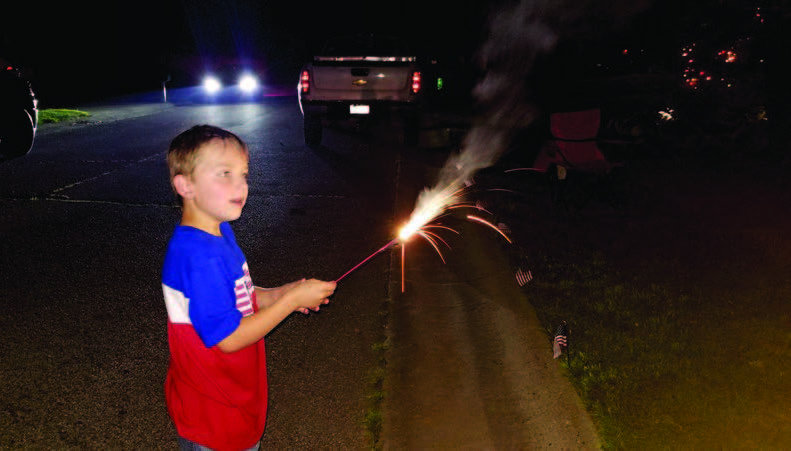
Outdoor activities, such as Fourth of July fireworks

Just time on the back porch are more enjoyable when residential mosquito control companies reduce the presence of biting mosquitoes.
ACKNOWLEDGEMENTS
Thanks to Dawn Minns for graphic design and Adduci Studios for illustrations. Thanks also to the following individuals who provided valuable comments and suggestions that improved this publication:
Travis Cleveland, University of Illinois
Mark Clifton, North Shore Mosquito Abatement District
Jennifer Gordon, Bug Lessons Consulting
Nikki Hendrickson, Advanced Turf Solutions
Katie Potts, The Greenskeeper, Inc.
Scott Robbins, Action Pest Control
William Stanuszek, Saginaw County Mosquito
Abatement Commission
Antonio Tiggs, The Greenskeeper, Inc.
DISCLAIMER
This publication is intended for educational purposes only. The authors’ views have not been approved by any government agency, business, or individual and cannot be construed as representing a perspective other than that of the authors. The publication is distributed with the nderstanding that the authors are not rendering legal or other professional advice to the reader, and that the information contained herein should not be regarded or relied upon as a substitute for professional consultation.
The use of the information contained herein constitutes an agreement to hold the authors, companies, or reviewers harmless for liability, damage, or expense incurred as a result of reference to or reliance upon the information provided. Mention of a proprietary product or service does not constitute an endorsement by the authors or their employers. Descriptions of specific situations are included only as hypothetical case studies to assist readers of this publication and are not intended to represent any actual person, business entity, or situation. Reference in this publication to any specific commercial product, process, or service, or the use of any trade, firm, or corporation name is for general informational purposes only and does not constitute an endorsement, recommendation, or certification of any kind by Purdue University. Individuals using such products assume responsibility that the product is used in a way intended by the manufacturer and misuse is neither endorsed nor condoned by the authors nor the manufacturer.

Reference in this publication to any specific commercial product, process, or service, or the use of any trade, firm, or corporation name is for general informational purposes only and does not constitute an endorsement, recommendation, or certification of any kind by Purdue Extension. Individuals using such products assume responsibility for their use in accordance with current directions of the manufacturer.
Find out more at
THE EDUCATION STORE
edustore.purdue.edu
